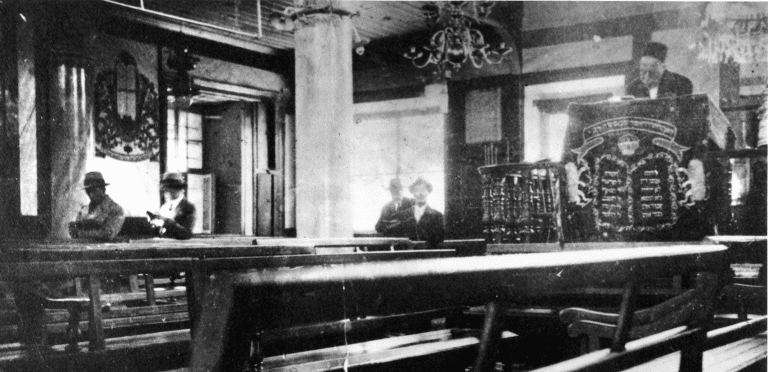
1930 photo of hazan Yehuda Levi, wearing a fez in the Kahal Shalom synagogue. (Kahal Kadosh Shalom) The “tevah” (prayer reading table) is in the center of the sanctuary.
The Jews of Rhodes were deeply connected to their spiritual roots and traditions. Life regularly revolved around Jewish holiday and Sabbath observance, interspersed by Jewish life-cycle events (weddings, circumcisions, bar mitzvahs, etc.)
Each household member had an important role in getting ready for a holiday. Before any special occasion the women would prepare sweet pastries and candies, which goes with the Ladino saying, “La kaza estava siempre yena para alegrias.” (The house is always full [ready] for happy occasions). The men would help with the shopping by collecting necessary items at the marketplace. Last, but not least, the children would assist in any other final minute errands requested by their parents. Therefore, religious celebrations have been an interaction of family members following religious traditions.
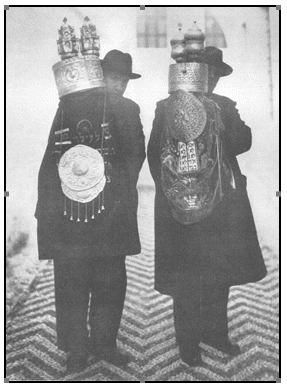
1933 photo of David Alhadeff and Nissim Alhadeff carrying the Torahs in the Kahal Grande (Kahal Kadosh Gadol) synagogue courtyard.
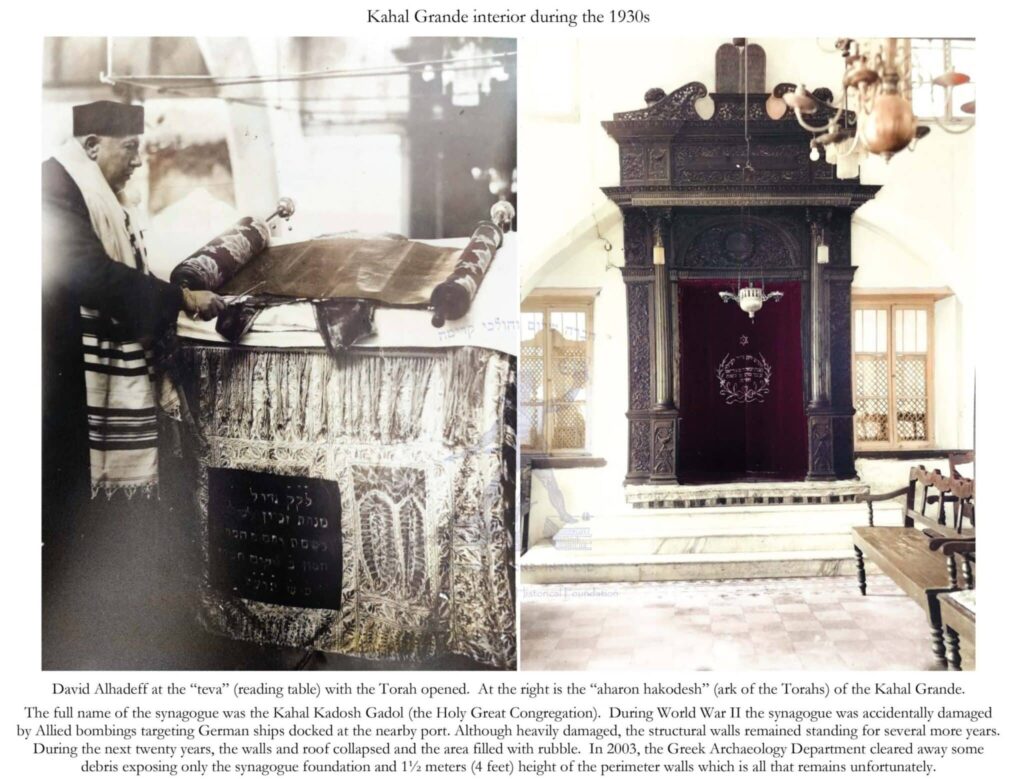
The Kahal Grande (Kahal Kadosh Gadol) of Rhodes before its destruction in WWII.
Celebrated in the beginning of the Hebrew month of Tishri, Rosh Hashana welcomes the New Year with health, happiness, and prosperity. Before this important occasion, the Jews of Rhodes observe “selihoth,” which are penitential prayers for forgiveness.
Once this day arrives, the children are excited to attend the early morning services, where the “shofar,” or ram’s horn, is blown. During dinner, symbolic foods are blessed as part of the “yehi ratsones” ceremony. Sugar is also placed on the table.
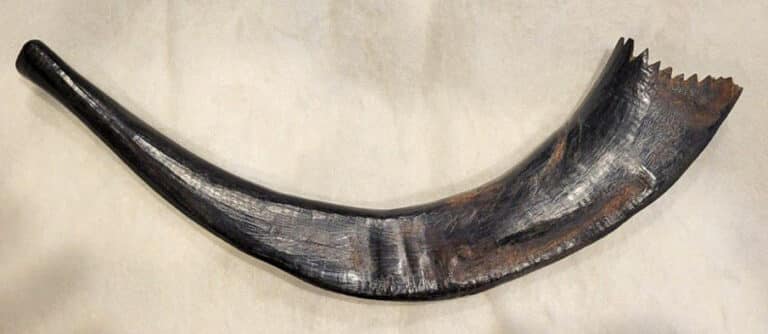
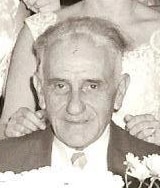

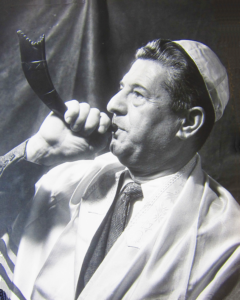
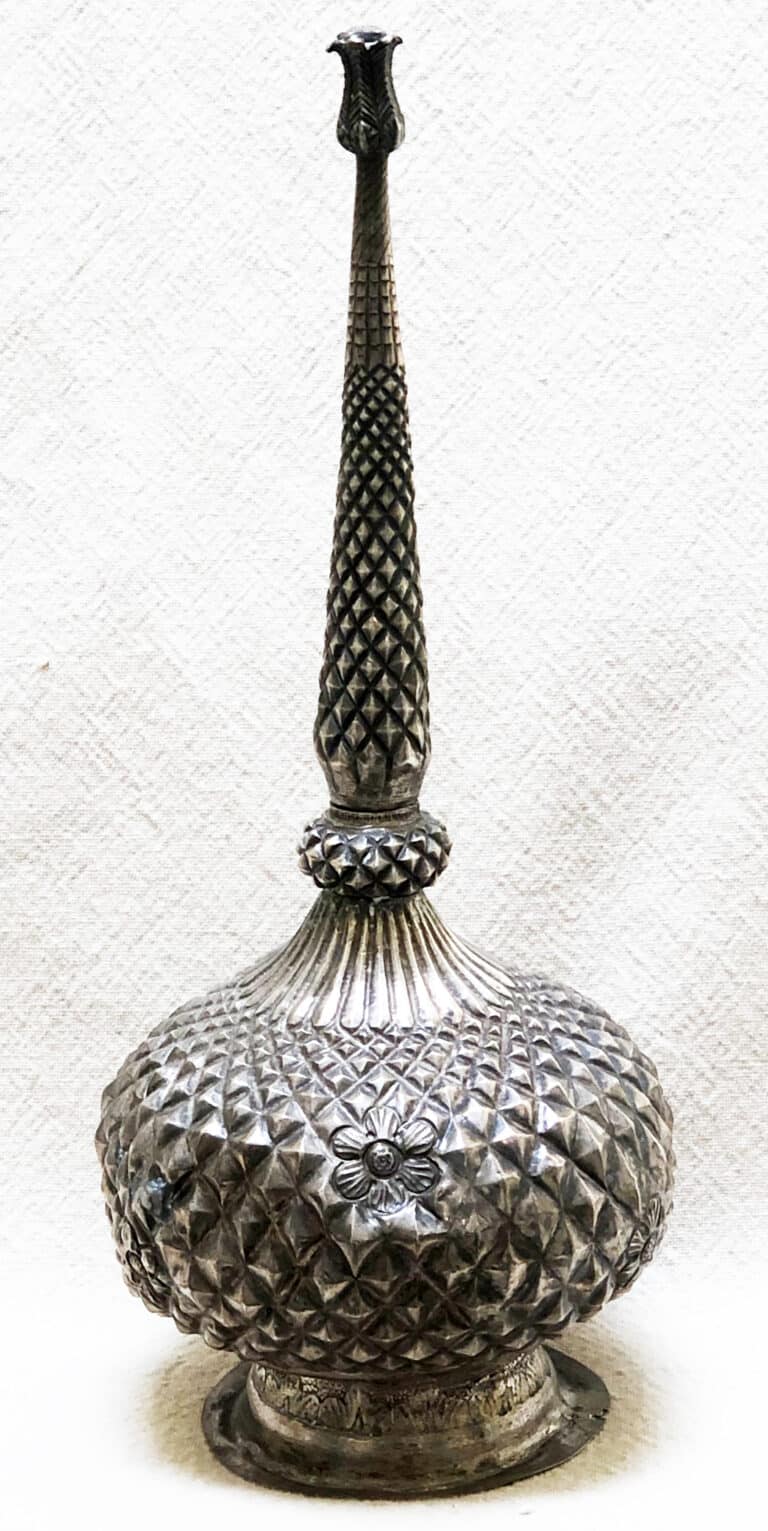
Silver Rosewater sprinkler from Rhodes
Photo: The rosewater would be dispensed by sprinkling from the long spout. Rosewater was also used at the end of the day of Yom Kippur to dispense the sweet smell of “agua de flor” to refresh the stamina after a long day of prayer services. Luna (“Lena”) Hasson Cohen brought this with her when she emigrated from Rhodes to the U.S. in 1935. (From the family of Rose Cohen Benon of Los Angeles).
“Before the day’s worship closed with the Neilah service, worshippers dipped their handkerchief into a container of rose water. The entire synagogue was redolent with this sweet fragrance as the congregation concluded its Day of Atonement prayers.” (The Jews of Rhodes by Rabbi Marc D. Angel)
Sukkot was another joyous occasion for the Jews of Rhodes because everyone got dressed up in their most festive clothing; they danced and sang holiday songs. The children were especially excited for Sukkot because they were responsible for assisting in decorating the Sukka. This temporary hut was covered with palm branches, myrtle, ornaments, fruits, colored paper chains, and embroidered tapestries.
“I can still remember the Succah we built in our little courtyard for celebration of Succot. Father constructed it meticulously, and we adorned it with palm branches and myrtle. How the sweet smell of the leaves mingles with aromas of blossoming orange trees or the grape vines…We would pray and study the tikkun beneath that simple splendor, ensconced in our observance and surrounded by Mother’s biscochos (cookies) and fruit we had hung on the Succah branches. (The Juderia by Laura Varon)
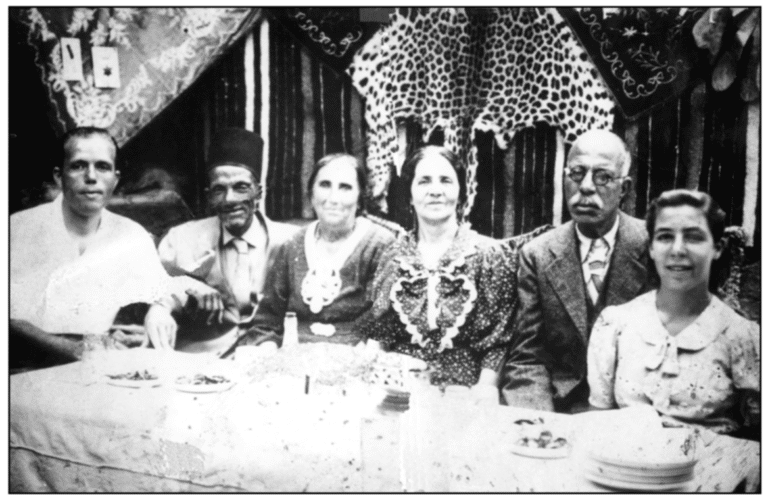
1932 photo celebrating Sukkot. L-R: Nessim Cohen, Jacob Cohen, Rebecca Cohen, Mirima Notrica Levi, Yehuda Levi and Renee Levi. From Selma Levy MIzrahi.
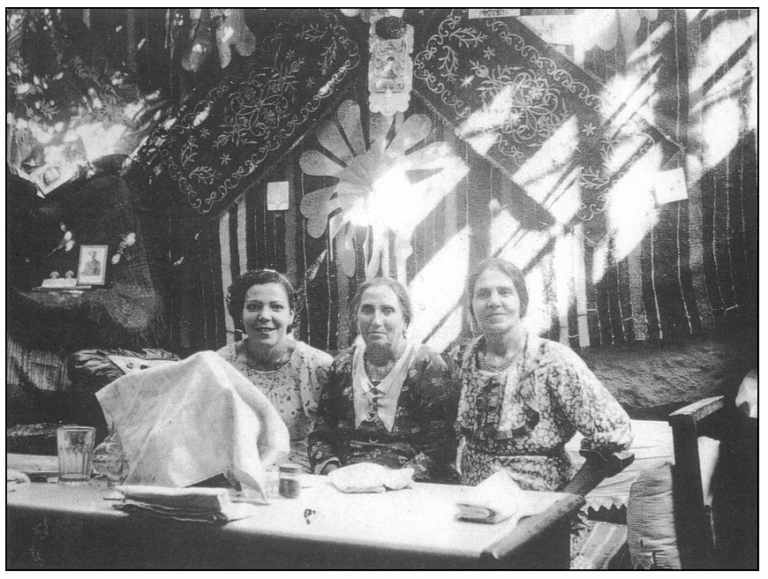
1935 Sukkot lunch in the courtyard of the Levi family home. L-R: Sarah Levi, Rifka Cohen and Miriam Notrica Levi. Notice the embroideries, known as “cevres” on the walls. From Stella Levi.
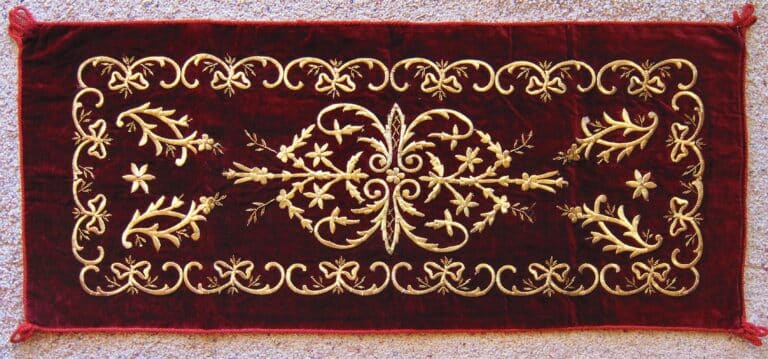
This burgundy-colored cevre is made of velvet with gold-metallic floral embroidery. (From Morrie Angel of Los Angeles).
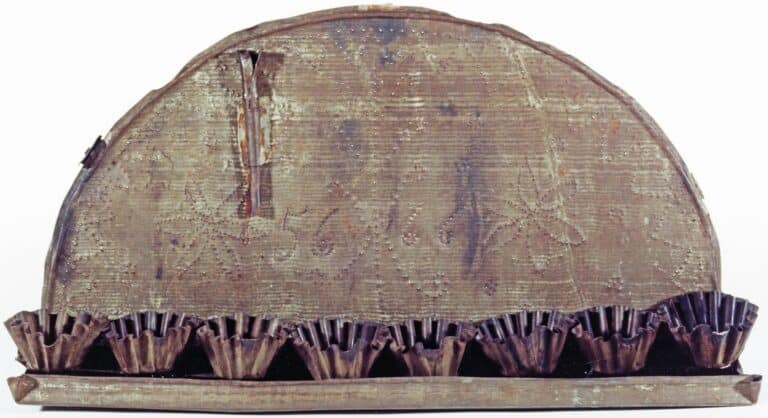
1906 Rhodes hanukia made of tin from the Bellina Hasson Gold Family, Los Angeles.
Photo: This tin “hanukiá” was made in Rhodes in the Hebrew calendar 5666 (1906), embossed on the back plate along with a floral design. The “hanukiás” made in Rhodes were simple and lit using pine needle wicks (wrapped in cotton) in olive oil. They were displayed in the windows of the family homes. The tinsmith of Rhodes at that time, Nissim Benveniste, made most of the “hanukiás” for the Jewish community at the turn of the 20th century and his primary employee was Yitzhak Amato.
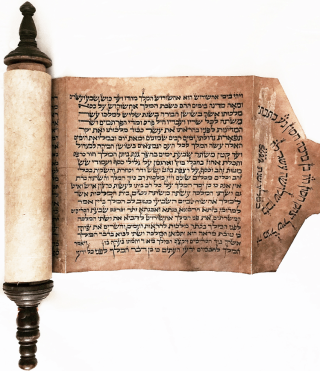
162-year-old Megillah (Scroll of Esther) was written in 5622 (1862) for Yitzhak Hasson, son of Baruch Hasson. The artifact is in the Jewish Museum of Rhodes.
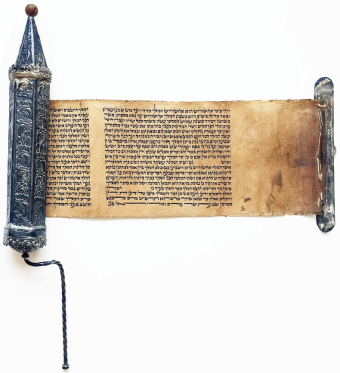
Another Megillah, circa 19th century, of Yitzhak Hasson is part of the traveling exhibition of the Rhodes Jewish Historical Foundation. It has been shown to seven Rhodesli and Sephardic Communities in the US.
Photos of Megillot: In 1920, Jamila (née Israel) Hasson and her two children, Caden and David, brought the megillot to New York when they immigrated to the United States. Jamila was the wife of Moshe, son of Yitzhak Hasson and Sarah Tarica. The historical items were from Randy and Moshe “Murray” Hasson of Hawaii.
The Megillah was used for Purim in Rhodes, celebrating the story of Queen Esther and her uncle, Mordehai, in saving the Jews from the evil plot to annihilate them. The holiday is celebrated with festivities that foster family and community unity and triumph over adversity.
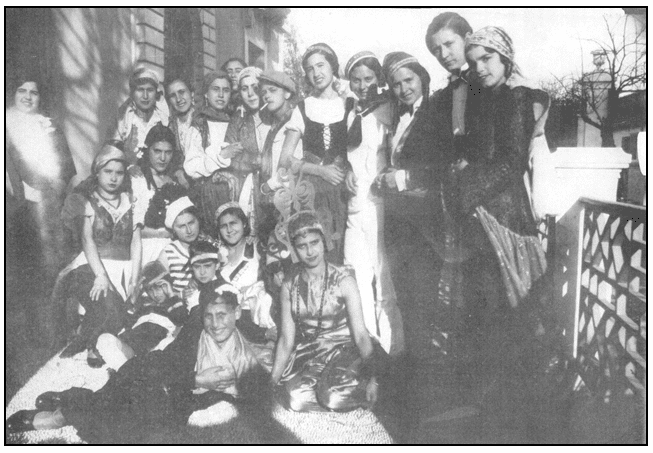
1930s Purim. Next to the wall: Graciela Cohen. Center: Alice Notrica standing on the left side of the woman with a hat and cigarette, Susan Misrachi, Rica Israel in a sailor costume and Graciela Menashe. Sitting in front: Peppo Notrica and Elsa Surmani with a headpiece. From Ana Pilosoff.
The streets of the Juderia were alive with celebrations on Purim day…They dressed in costumes and played games in the roads. Families sent gifts of foodstuffs (Purim Platters or Platikos di Purim) to relatives and friends. These packages, usually containing candies and baked goods, were delivered by the children. (The Jews of Rhodes by Rabbi Marc D. Angel)
These platters (Platikos) containing sweets and a glass of wine or water were delivered and a message was recited: “Bivas komo l’agua freska, ke tengas la kaza yena komo il guevo.” (“May you live as the fresh water; may your home be as full as the egg.”)
“Purim lanu, Pesah en la mano (Purim is here, Passover is near) is an expression used at this time.
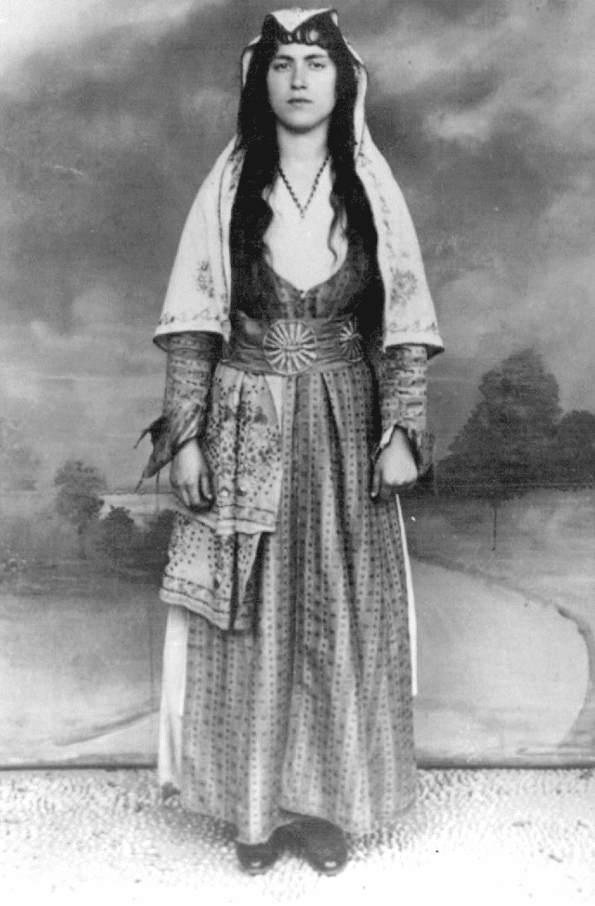
1918 Purim of Amelia BarDavid Levy. From Deborah Levy Hatherly.
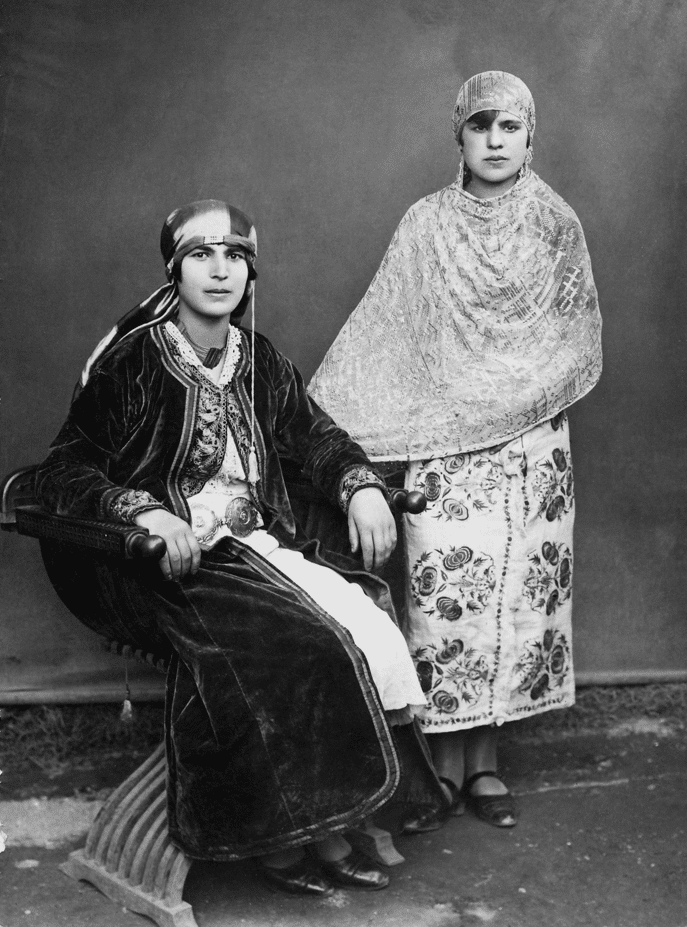
Rebecca Amato Levy and Amelia Israel (Bendicha). From Rebecca Amato Levy.
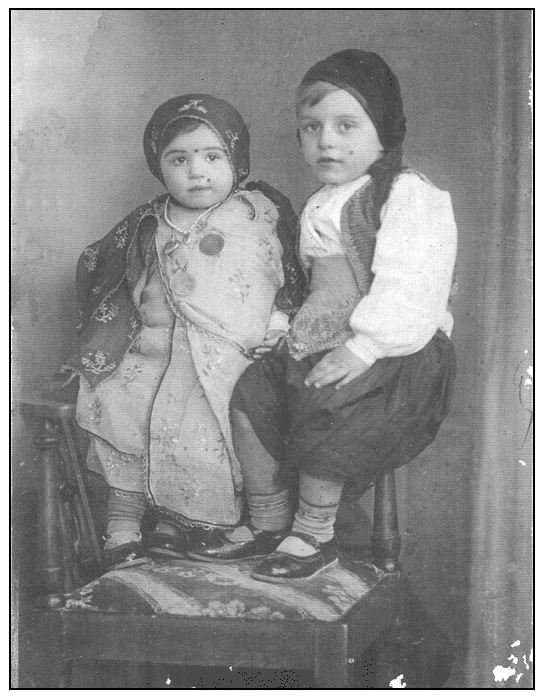
1933 photo of Matilda and Eliezer (Elie) Soriano in Purim costumes. From Elie and Corinne Soriano.
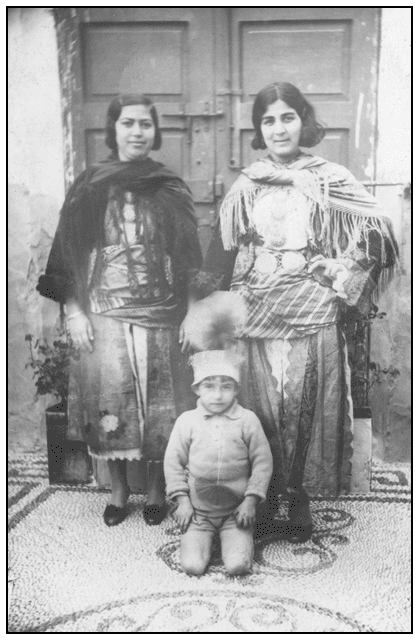
1934 photo of Purim costumes of Matilda Hasson Cohen (left) and Lea Amato Huniu (right). The boy in front is a neighbor. From Jack and Kaye Israel.
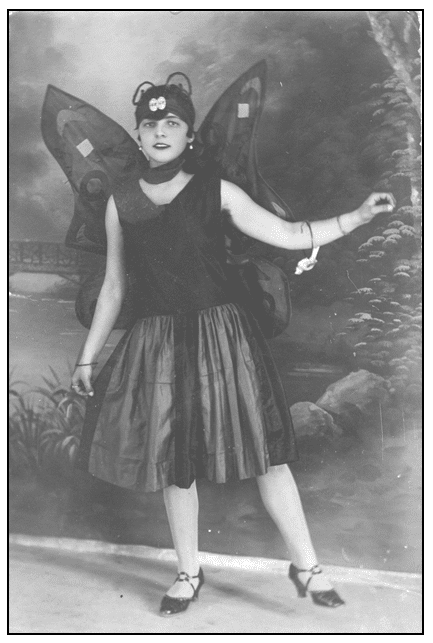
1935 photo of Rebecca Notrica. From Rebecca and Neil Sheff.
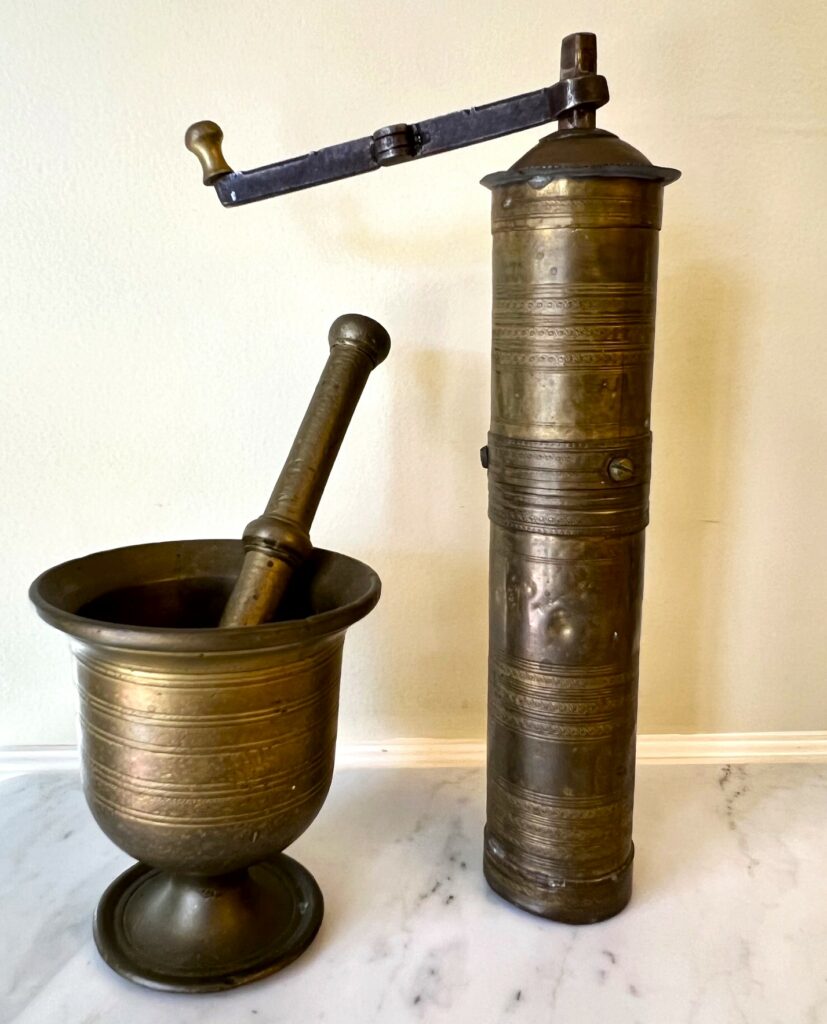
Mortero (mortar and pestle) and grinder from Rhodes. From the family collection of Leo and Mati Franco. Mati was the daughter of Rebecca Amato Levy.
“The weeks before Pesah were filled with hard work, and as mentioned earlier everyone pitched in. The young girls were required to do all the grinding with the mortero or mortar and pestle. This included starting from the salt, pepper, cinnamon, cloves, matzahs to make the meal and farfel, as well as grinding the nuts.”(I Remember Rhodes by Rebecca Amato Levy)
“De Purim a Pesah-mejor que mi madre no me pariera, (From Purim to Passover-I wish I hadn’t been born). The reference is to the thorough, meticulous cleaning of the entire house, outside, inside, walls, courtyards, furniture, cupboards, the kitchen and everything in it…the month from Purim to Passover was a period of hard work for the women of Rhodes; it was natural for women to ask their daughters to help (and for them to complain). But when the evening of the Seder arrived, how lovely everything looked!”(A History of Jewish Rhodes by Esther Fintz Menasce)
“During the ceremonial dinner, the Judeo-Spanish song, “Todo el ken tiene ambre venga i koma” (All those who are hungry come and eat) welcomed the needy to share in the festivities. At the conclusion of the Seder, they sang the ancient folk songs “Un kavritiko” (One Little Lamb) and Ken supiese i entendiese” (He who knows and understands). The ceremonial dinner seemed never-ending since the Agada was read both in Ladino and Hebrew and every step of the ritual was performed to perfection.” (Jewish Rhodes: A Lost Culture by Isaac Jack Levy)

Song of Songs booklet printed in Rhodes 5690 (1930) of Jacob Surmani Eliau
“Prior to the afternoon service on the first two days of Passover, it was customary to chant the Song of Songs in the synagogues. Each verse was sung first in Hebrew and then in a traditional Judeo-Spanish translation.” (The Jews of Rhodes by Rabbi Marc D. Angel).
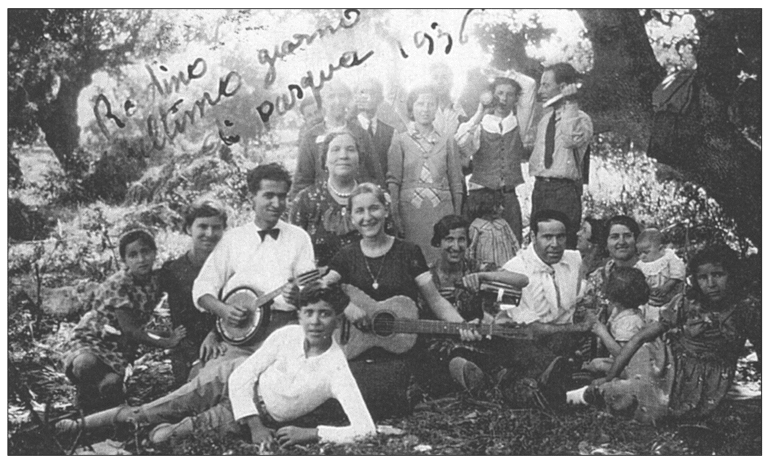
Photo: Picnic on the last day of Passover (Pasqua Ebraica, Pesah) in 1936 at Rodino park during the Italian period From Salvo Alcana. Playing the banjo is Isaac Pilosof. The young woman at his right shoulder is Estreya Leon. In front, center is Viola Alcana and Sarina Alcana. On the right side: Benzion Levy and family. The older woman in the center is Behora Alcana; behind her is Eliezer and Mazaltov Pilosof and Pepo Alcana. *Rodino Park is also known as Zimbuli or Rodini.
“When the weather was nice, the festivities were even more heartfelt. In Rhodes, for example, a picnic was a must for the last day of Passover. Everyone was there…Some went in the direction of Rodini, others toward Trianda, and still others to Sirinella, where there were beautiful beaches.” (For This I Lived by Sami Modiano)
“The tranquil and simple life in the Juderia of Rhodes was enriched by the strict observance of the Sabbath and the religious festivals; as Elsie Menasce reminds us, “the eternal cycle of Shabbat and the Moadim (festivals) lent color and depth to the lives of members of the community.” (A History of Jewish Rhodes by Esther Fintz Menasce)
Shabbat preparations began on Thursday night, as the women of the household prepared the Sabbath meals, cleaned the house, and changed the linens. Friday morning and afternoon were full of activities for a Rhodesli housewife. Once all the work was done late Friday, the families cleansed themselves by going to the Turkish bath. (“banyo turko” or “hamam”).
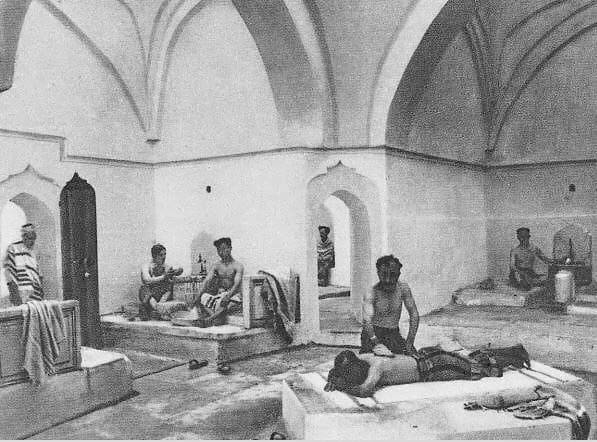
Hamam in Rhodes
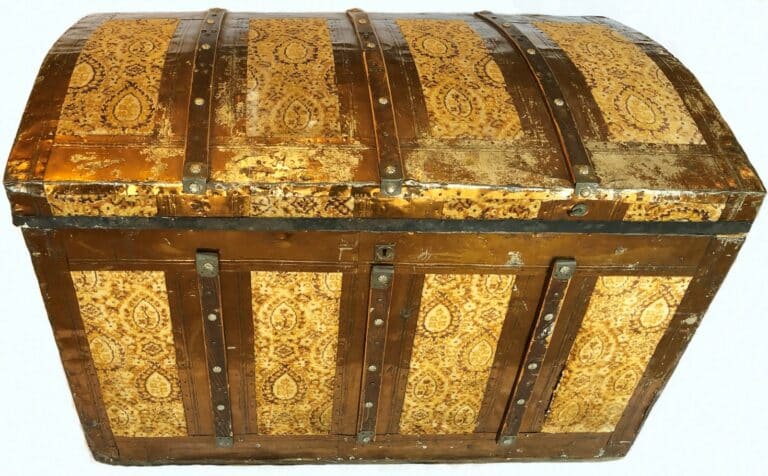
Photo: This Baul was made around the early 1900s in Rhodes using wood, velvet fabric of a floral pattern, and metal reinforcement. The Baul usually contained a bride’s trousseau or “ashuar or ashugar)” and also functioned as a luggage piece when a person traveled. It was brought to the United States in 1915 by Perla Benveniste Menasche when she came with her nephew Elia “Liachon” Menasche.
“At fifteen, Renee set to work on that trousseau, she and Miriam together…She made Renee a beautiful camicia da notte of satin; she embroidered table linen and the borders of hand towels.” (One Hundred Saturdays~ Stella Levi & the Search for a Lost World by Michael Frank)
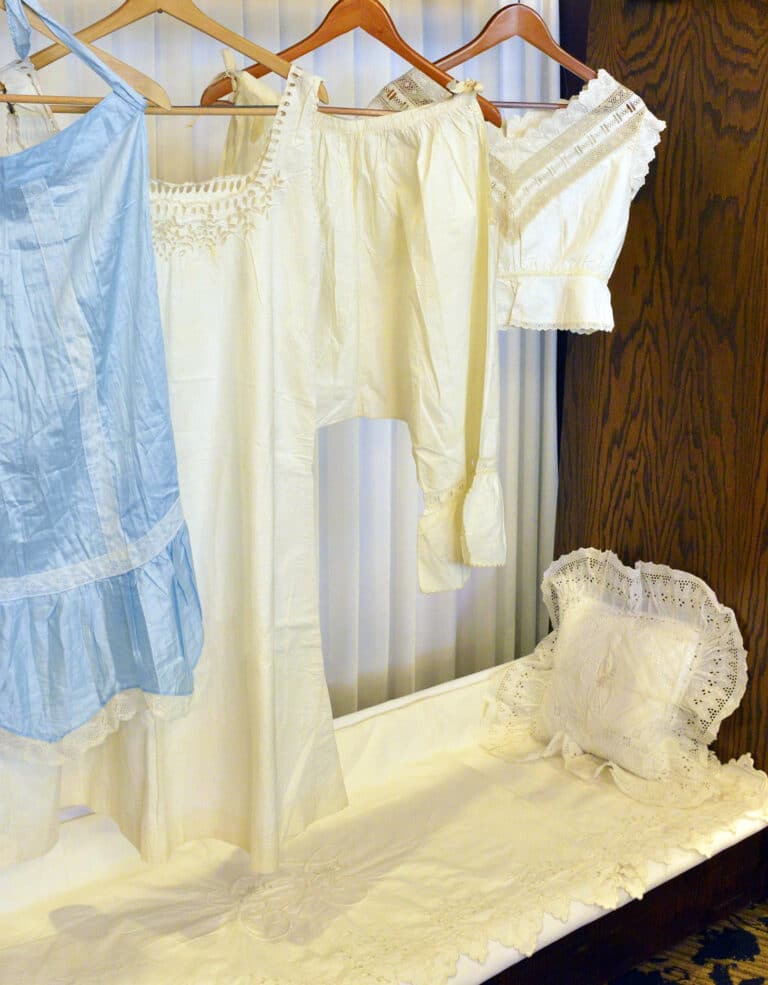
These handmade clothing and embroideries were part of Ester Touriel’s “ashuar” from her first marriage to Baruch Capeloto. From the family of Louise Chiprut Berman of Seattle. Photo from the Jewish Life in Rhodes Exhibit, New York, 2023

Photo: This silver Kucharera with 2 containers were from Rhodes and was used as a holder for the spoons and forks that served sweets (dulces). It was used for special gatherings, celebrations and holidays. These were given to Victoria as part of her trousseau by her mother, Rachel Tarica. From the family of Joseph and Victoria Hasson family of Los Angeles. The historical items are displayed in the Jewish Museum of Rhodes.
“The “vijita” (the displaying of the “ashugar” always started at 3:00 (pm) with the passing of a tray of two types of sweets… A circular silver fork and spoon holder called a cuchariera or apuntador de peron i cucharas and a silver glass holder were placed on the tray with a glass of water for the used silverware…After the meal, there was much singing and dancing in honor of the bride. Later on, fresh lemonade and sponge cake were served, and still later they served “bouloucounou” (sesame seed candy), “baklava” and turkish coffee and finally “marzipan”. (I Remember Rhodes by Rebecca Amato Levy)

A platter of decorated masapan (marzipan) is served during celebrations such as engagements, weddings, gatherings, etc. These screenshots show a sprig of aruda with gold leaf (alvarak) placed on top of the covered masapan and bonbonieras (bombonieres, Jordan almonds). From the digitized 16mm film clip: 1948 Sephardic engagement party of Israel “Ted” Hasson and Pearle Benon (Benoun) in Los Angeles by Aron Hasson.
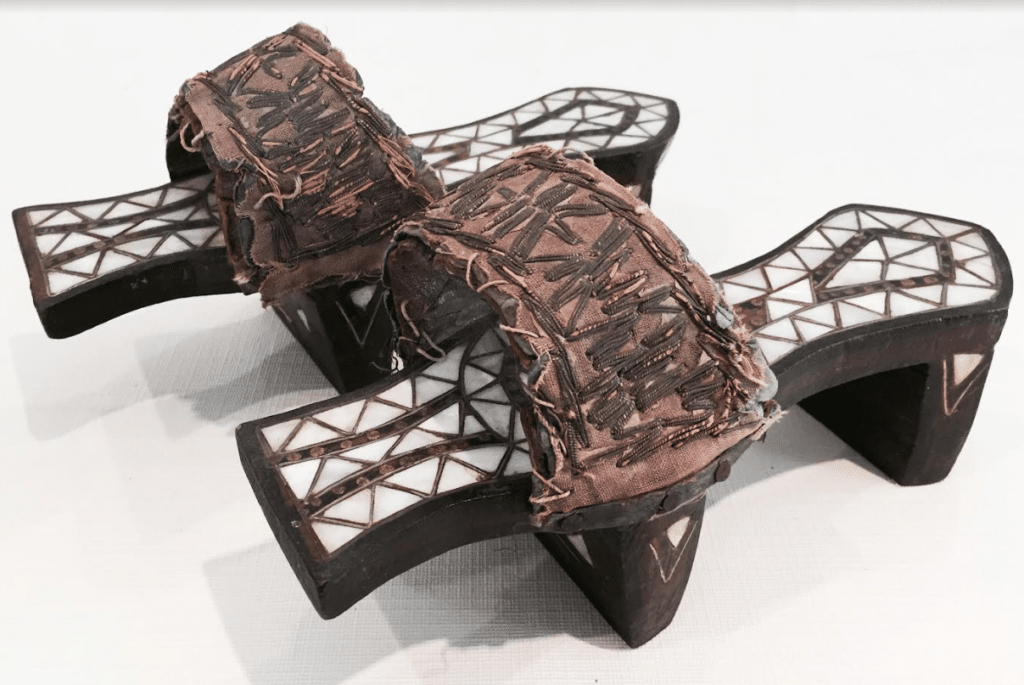
Photo: Circa 1920s Mikveh “Takos” from Rhodes. (From Randy & Murray Hasson of Hawaii).
“The traditional wedding day was Friday. The day before was the day of the baño de novia (the bridal bath), which started early in the morning…The “sposica” (young bride) wore takos de boda (clogs inlaid with mother-of-pearl). Water was poured from a brass bowl (tas) over her head, round which, when the hair had been thoroughly washed, a yashimak (yasmak)-a square veil with ornamented borders was worn. (A History of Jewish Rhodes by Esther Fintz Menasce)
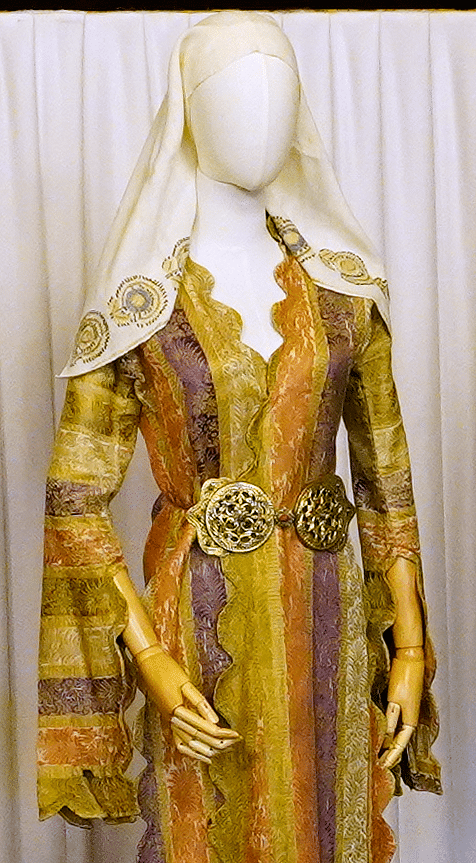
An example of an embroidered yasmak (ornamented square veil) to be worn as a hair cover. The multicolored entari was from Kathy Mello of Berkeley (Alhadeff & Fiss Family). Photo from the Jewish Life in Rhodes Exhibit, New York, 2023.
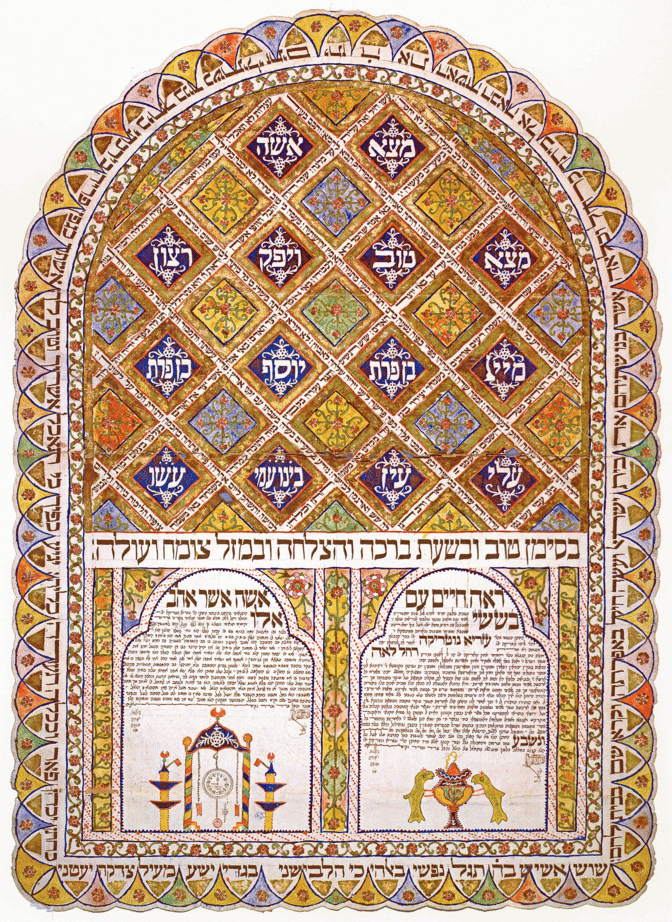
This Ketuba was made for the 1873 marriage between Azariah Notrica and Rahel Leah Tarica. Their children were Isaac, David, Eliau, Regina, Rosa, Mazaltov (Matilde) and Marie. (From the Pauline Franco and Tom Cordova Family of Los Angeles)
Until the 20th century, marriages were usually arranged by parents rather than by children. Weddings were always a time of celebration.
A typical Jewish wedding in Rhodes began on a Friday afternoon with a procession from the bride’s home to the synagogue where the wedding ceremony was to be held.
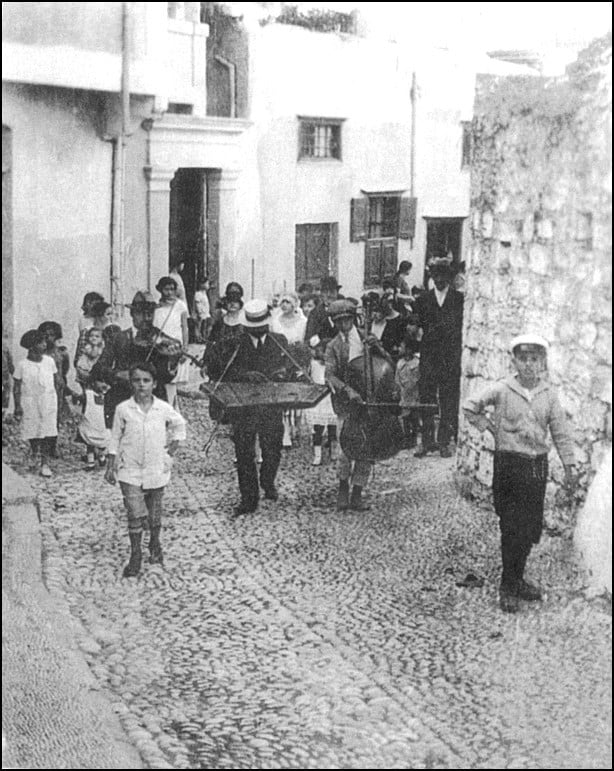
1930 wedding procession, led by a musical trio of a violin, xylophone (“kannon”) and cello. From Esther Amato Pergament.
Bridesmaids, guests and musicians surrounded the bride as her father led her through “La Juderia” (the central streets of the Jewish Quarter). Before leaving her house, she had to ask permission from her parents with this Ladino phrase: “With your permission, I want to go with my husband”. Then she kissed the mezuzah and proceeded to the synagogue as her relatives threw rice in the air.
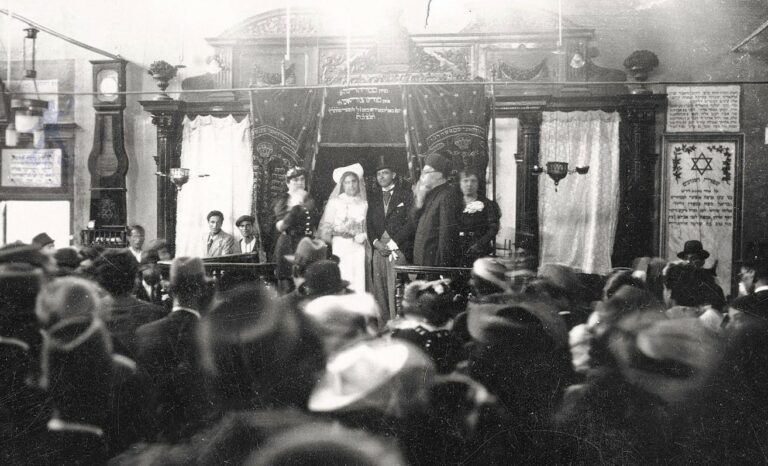
1937 wedding of Edward Menasche (son of Simon and Sarah) and Renee Surmani (daughter of Jacob and Sarah Notrica) at the Kahal Shalom. From Zen Amoils.
Once the procession arrived at the synagogue the service began. The bride and groom stood under a specially designed canopy called a “huppah” which represented the couple’s future home. Covered with a “talet” or prayer shawl, the “nisuin” which were the 7 wedding benedictions were recited to the bride and groom during the blessings.
Afterwards, the rabbi/cantor read the bride and groom’s marriage contract known as the “ketubah”, followed by two witnesses signing this contract. To end the wedding the groom stepped on a glass and broke it as a symbolic reference to the destruction of the temple in Jerusalem.
The costuming for this special occasion was very particular. The Sephardi bride’s wedding gown was a very special European-style dress and was always white. Earlier Turkish-style dresses were decorated with embroidered tree patterns to represent the “tree of life”. The bride always wore jewelry; on her head the bride wore a long veil or scarf which covered most of her hair and head.
While many of these traditions are no longer practiced today, several of them are followed at Sephardic weddings all over the world.
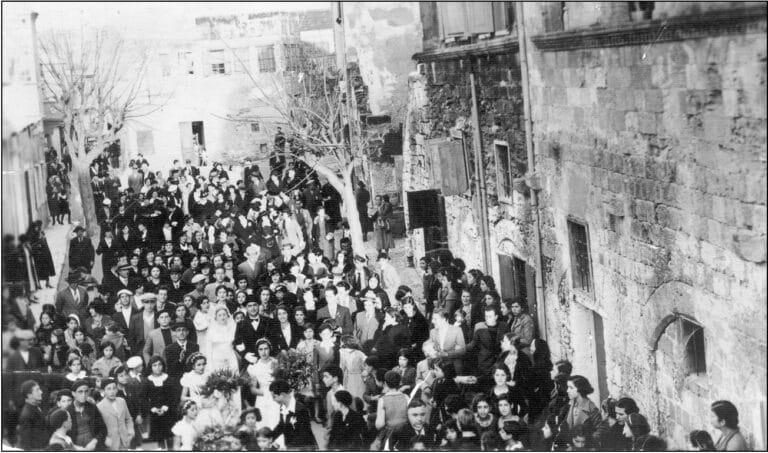
1935 wedding procession of Daniel Behor Israel and Julia Hasson along “La Kay Ancha” in the Jewish Quarter of Rhodes. From Joseph and Victoria Hasson.
Images from Harry Benveniste and Rebecca Rousso wedding. From Arthur and Jeanette Benveniste.
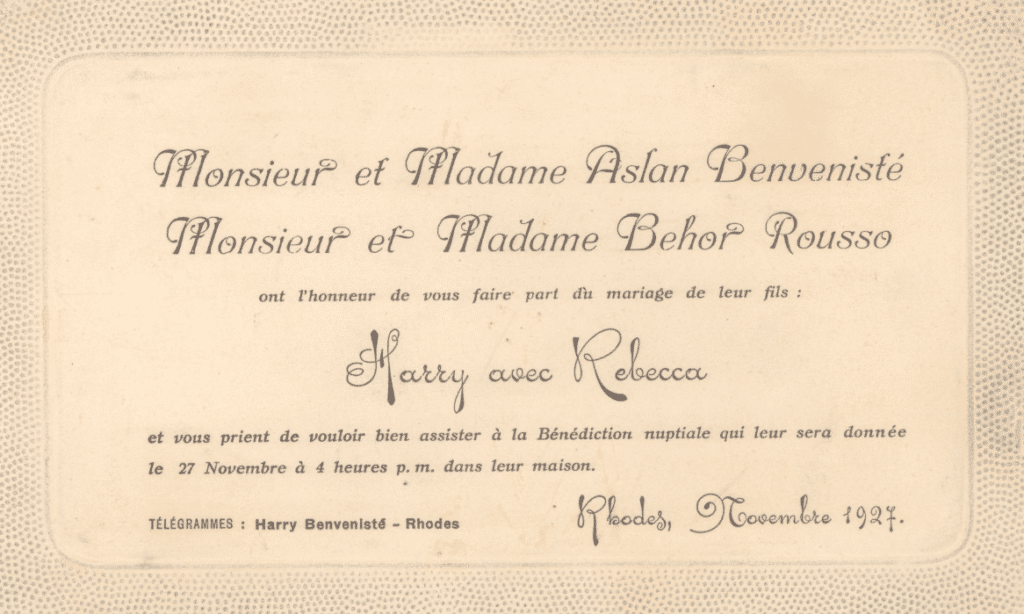
1927 invitation of the Benveniste & Rousso wedding
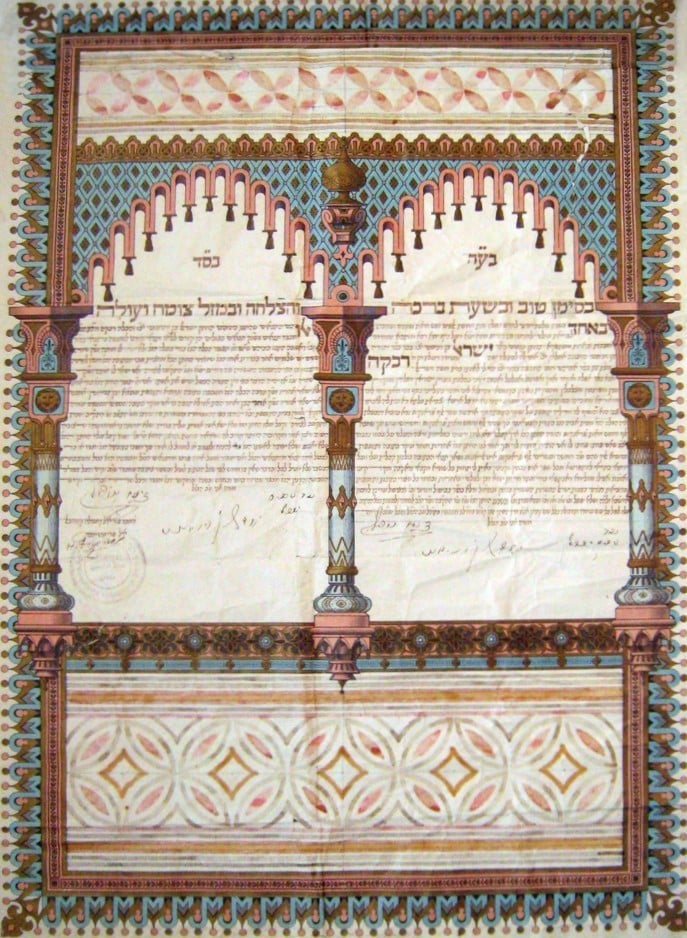
Benveniste & Rousso Ketuba
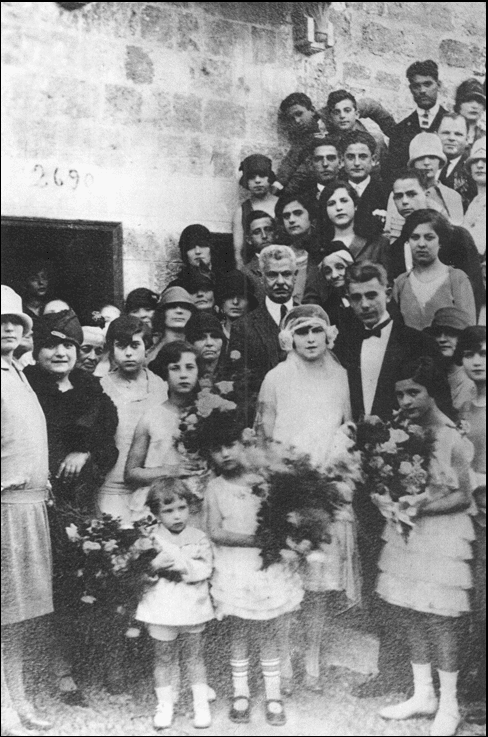
1927 wedding photo of Harry Benveniste and Rebecca Russo at the stairs of the Benveniste family home.
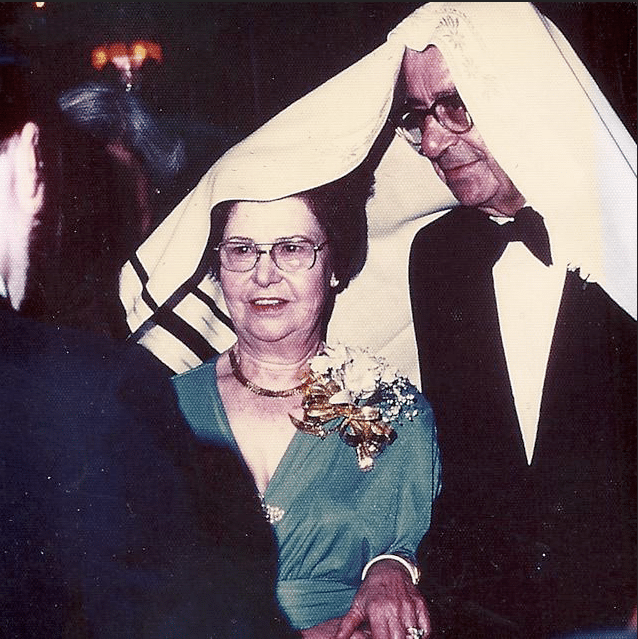
At their 50th Anniversary
The hand-embroidered lace made by Emily Bardavid Levy, was a wedding gift to her daughter, Sylvia Levy and Max Benator. The beautiful piece highlights the delicate floral design, which include a phrase “Dio Ti Guardi” (May G-d protect you) and “la Tesoro” (treasure). The historical item was donated by Emily’s granddaughter, Deborah Levy Hatherley of Alpharetta, GA.
A celebrated occasion “Berit Mila” (circumcision) is done on the eighth day of the life of the newborn son.
“Throughout the night preceding the day of circumcision, two people guarded the baby. Known as shemirah or watch, this ceremony was designed to protect the baby…A sword was hung in the child’s room in order to ward off evil spirits.” (The Jews of Rhodes by Rabbi Marc D. Angel)
“The newborn boy had a quitada (godmother) and a quitado (godfather). The circumcision of the newborn boy was an important celebration…Generally, the newborn girl was not taken to the synagogue. She was named at home, in the arms of the quitada, during the ceremony of “las fadas.” (A History of Jewish Rhodes by Esther Fintz Menasce)
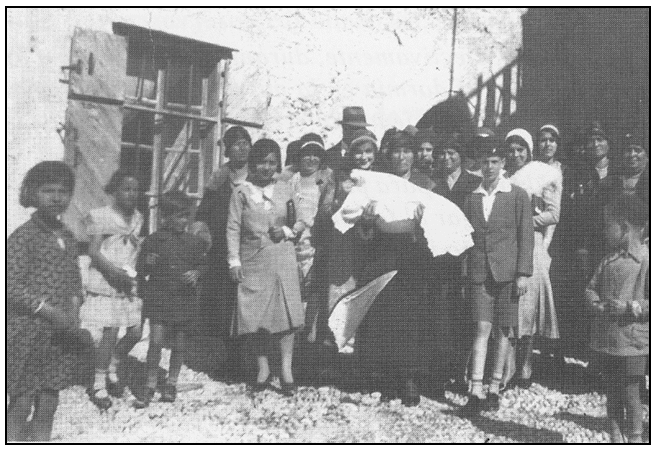
May 1931 procession to the Kahal Shalom for the “beraha de berit” (brit mila) of Victor Soriano, the son of Gedalia Soriano and Rosa Notrica. He is being carried by his “ketada” (godmother) in the procession on the way to the synagogue for the circumcision. Victor and his family immigrated to Buenos Aires before World War II. From Victor and Samuel Soriano.
1955 “Pidyon Haben” (redemption of the first-born son) ceremony that follows the Rhodes tradition. It was handwritten in Judeo-Spanish (“Ladino”) by Rabbi Michel Albagli. (From Louise Albagli of Portland)
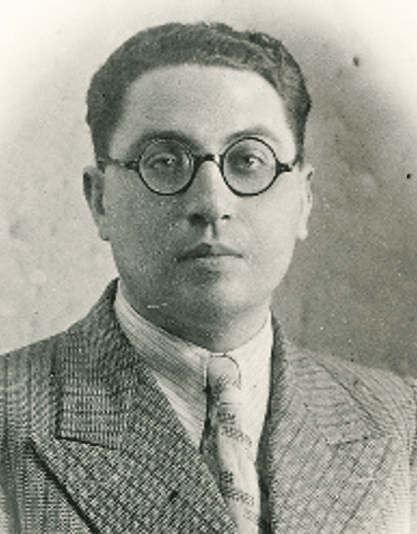
Rabbi Michel Albagli graduated from the Rabbinical College in Rhodes and served as the Chief Rabbi from 1936 to 1939. He immigrated to the US in 1939 and served the Rhodesli communities in Montgomery, Los Angeles, and Portland, Oregon.
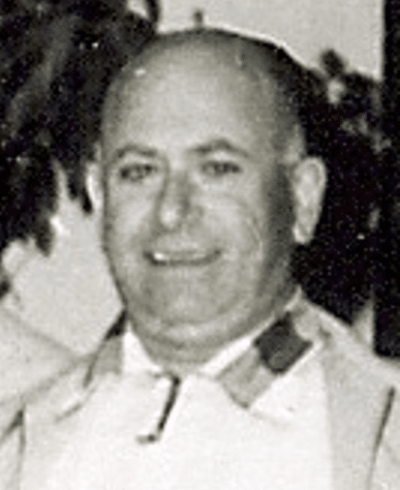
A copy of the original Pidyon Haben was sent to Haim Cohen in New York in October 1955. Haim wanted to follow the Rhodes tradition. Pidyon Haben is a ritual ceremony where the first-born male of a family is redeemed from a Cohen. Haim Cohen was the Cohen “gadol” who often performed this custom in New York and later in Los Angeles.
“The Bar Mitzvah was celebrated in Rhodes on either a Monday or a Thursday morning when the boy donned the “Tefilin”. These were the days that the service included the Torah reading. The following Saturday, the Bar Mitzvah boy read the “Perasha” or the portion of the Torah for the day…There were never Bat Mitzvah celebrations in Rhodes.” (I Remember Rhodes by Rebecca Amato Levy)

The tefillin are two small boxes containing Hebrew parchment scrolls used for religious prayer. They are worn on the left arm and around the head, attached with leather straps. The tefillin from Rhodes belonged to Israel Behor Hasson. The artifact is displayed at the Jewish Museum of Rhodes. From the family of Israel “Ted” Hasson of Los Angeles.
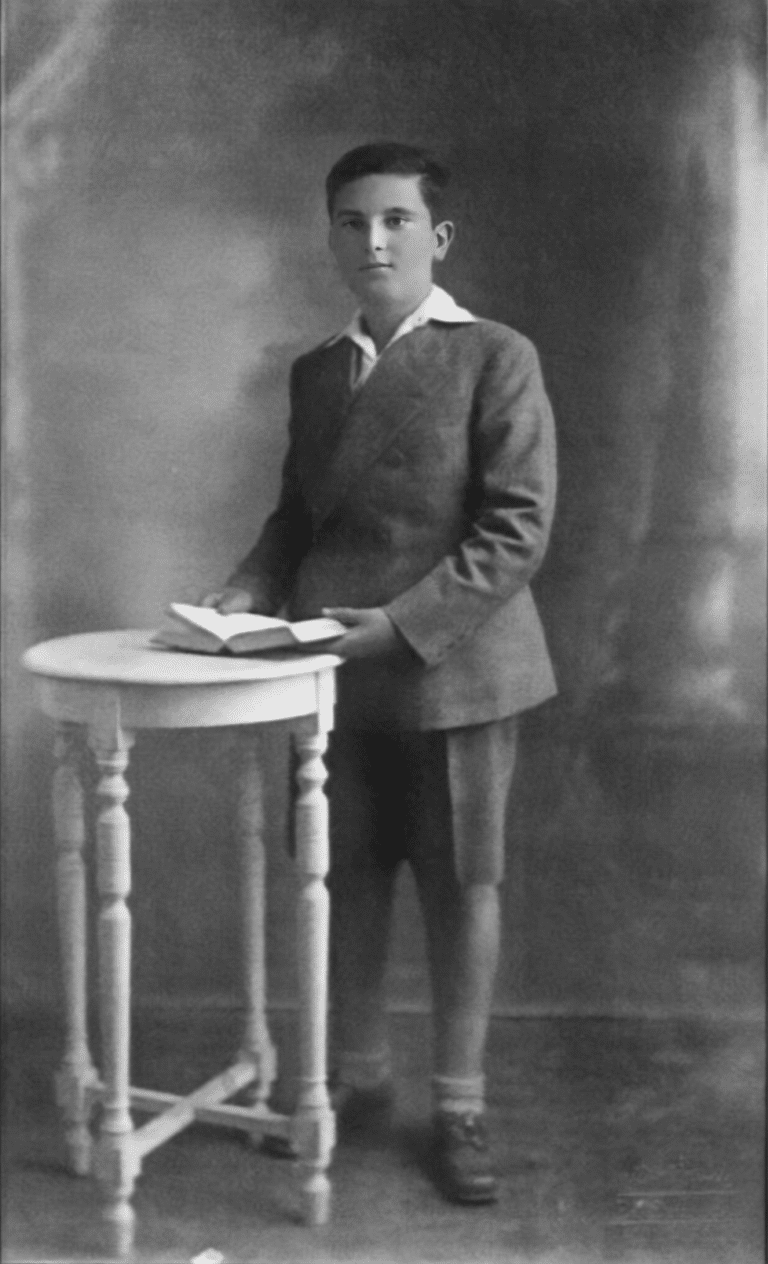
Clement Galante in his new suit ready for his Bar Mitzvah
“Mother made all of our clothes and grandmother mended our socks and knitted items to wear. I do not remember having new ready-made clothes until I reached my 13th birthday and was preparing for my Bar Mitzvah. I studied for my Bar Mitzvah along with other boys my age at the Synagogue called Kahal Shalom. Our teacher was Haham Yacov Kapuya (a relative of my mother’s)… (From Rhodes to Rags to Roses~ Tales of a Life Well-Lived by Clement E. Galante)
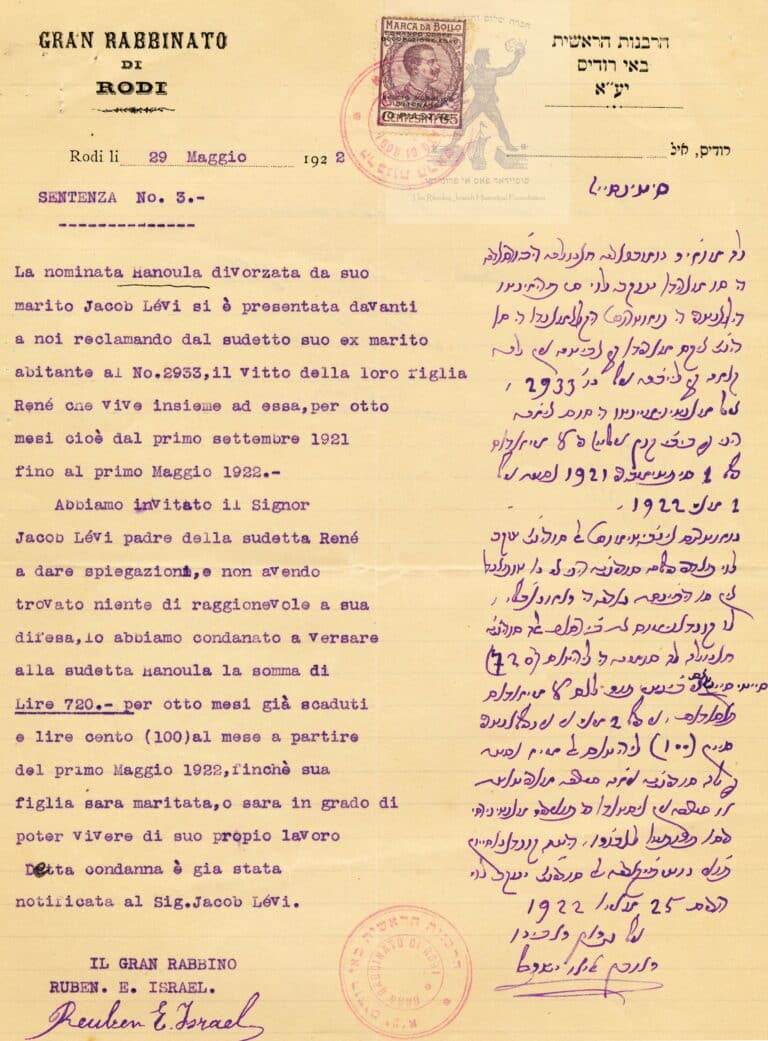
Divorce decision ordering spousal and child support
This decree relates to the Grand Rabbi Reuben Eliyahu Israel’s decision in the marital divorce between Jacob Levi and Hanula Hasson, ordering the spousal and child support payment amounts. The decree is written on the left side in Italian and on the right side in the Judeo-Spanish handwriting.
“The rate of divorce among Rhodian Jews was always low…Social stigma, rabbinic pressure, the financial obligations of the ketubbah all contributed to discourage divorce…yet divorce, when necessary, was an option that carried no taint of sinfulness. Divorce was a regular procedure of Jewish Law, and the bill of divorce (“get”) was issued by a competent rabbinic court.” (The Jews of Rhodes by Rabbi Marc D. Angel)
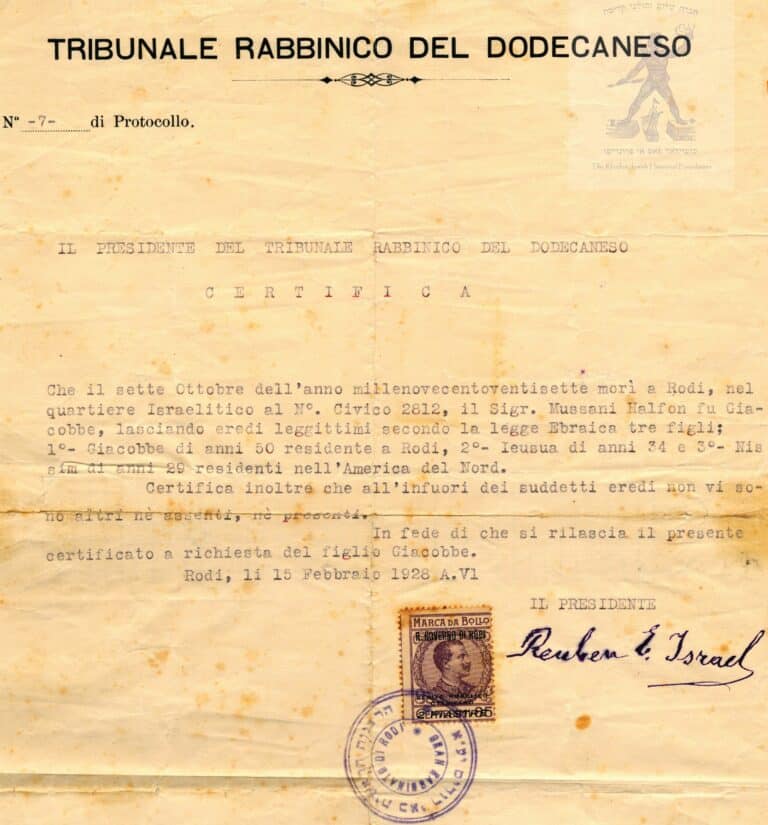
Halfon Inheritance
The Jews of Rhodes were allowed to operate their own judicial systems in various degrees under both the Ottoman and Italian rule. This autonomous judicial authority (“Bet Din”) was utilized in all types of cases–ritual, business, family law, inheritance and criminal law.
Partial translation: Rabbinical Court of the Dodecanese, the President of the Rabbinical Court, Certifies that on the 7th of October, the year 1927, the Mr. Mussani Halfon son of Jacob, died in Rhodes in the Jewish Quarter of the house No. 2812, leaving legitimate heirs according to Jewish law three children: 1- Jacob, 50 years old and a resident in Rhodes, 2- Yeushua, 34 years old and 3- Nissim, 29 years old residing in North America… In witness whereof we issue this certificate at the request of his son Jacob. Signed by Reuben E. Israel, the Grand Rabbi of Rhodes.
“Although traditional Jewish law did not normally allow daughters to inherit with their brother, early custom among the Jews of Rhodes did permit a married woman inherit a “nice portion” of her father’s estate…Apparently, when there was no objection from the brothers, their sisters routinely shared in the inheritance.” (The Jews of Rhodes by Rabbi Marc D. Angel)
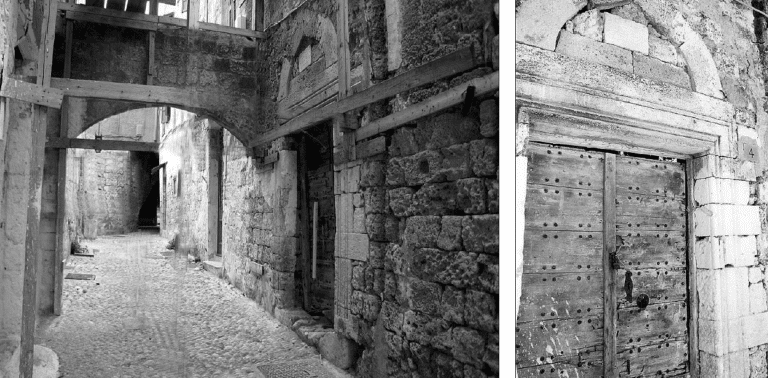
“The coffins of the Jewish Community were held in this room, which is a street away from the Kahal Shalom, known as “Kalijika de la Havra” (now #4 Vizantiou Street). Also, this room was used as the temporary place of holding the religious prayer books that needed to be buried later at the cemetery.” (A Guidebook to the Jewish Quarter of Rhodes by Aron Hasson)
“When a person was dying, two persons from the Bikur Holim would be at the bedside at all times. There would be a constant rotation, day and night. When a person died, the Bikur Holim took the responsibility of arranging the funeral. If it was a woman who died, then the Rohesas (the woman in charge), would do the bathing, cleaning and sewing of the shroud. If it was a man, the Rohesim (the men) would do the bathing and cleaning, but the Rohesas would sew the shroud.” (I Remember Rhodes by Rebecca Amato Levy)
“Mazal was the centerpiece of the street…but this man was on the move and often, because it also fell to him to lead funeral processions through the Juderia. “Pasa la misva!” he called out as he approached. “Pasa la misva!”. If you were in the street, you ran in the opposite direction…And if you’re at home, you closed any windows that looked out onto the street, and you backed away from the front door by a minimum of three feet–everyone, not just the children.” (One Hundred Saturdays~ Stella Levi & the Search for a Lost World by Michael Frank)

La Puerta de la Ciudad (Gate of Saint John, Koskinou Gate)
“A funeral procession would begin at the family’s home and proceed to the old Jewish cemetery, a short walk outside “la puerta de la ciudad” (Koskinou Gate, also called the Gate of Saint John), which was near the “La Fasana” area of the Jewish Quarter. Only men would be in the procession, not women nor Cohanim.” (A Guidebook to the Jewish Quarter of Rhodes by Aron Hasson)
“The ritual mourning lasted seven days. The memory of it remained engraved in my childish mind. They called it “sentar en siete” (seated for seven days)…All male members wore black ties and armbands, did not shave and sat on the floor their legs crossed under them (in a manner of a tailor), around a huge white tablecloth spread on the floor. Professional mourners, the “endechadoras”, about half a dozen of them, also sat round the tablecloth, took turns in their lamentations, cries of pain, sang at the top of their voices, their endechas, which exalted the good deeds, the merits and the virtues of the deceased…(Le Chene de Rhodes by Vittorio Alhadeff, English translation by Rachel Alhadeff Roditi)
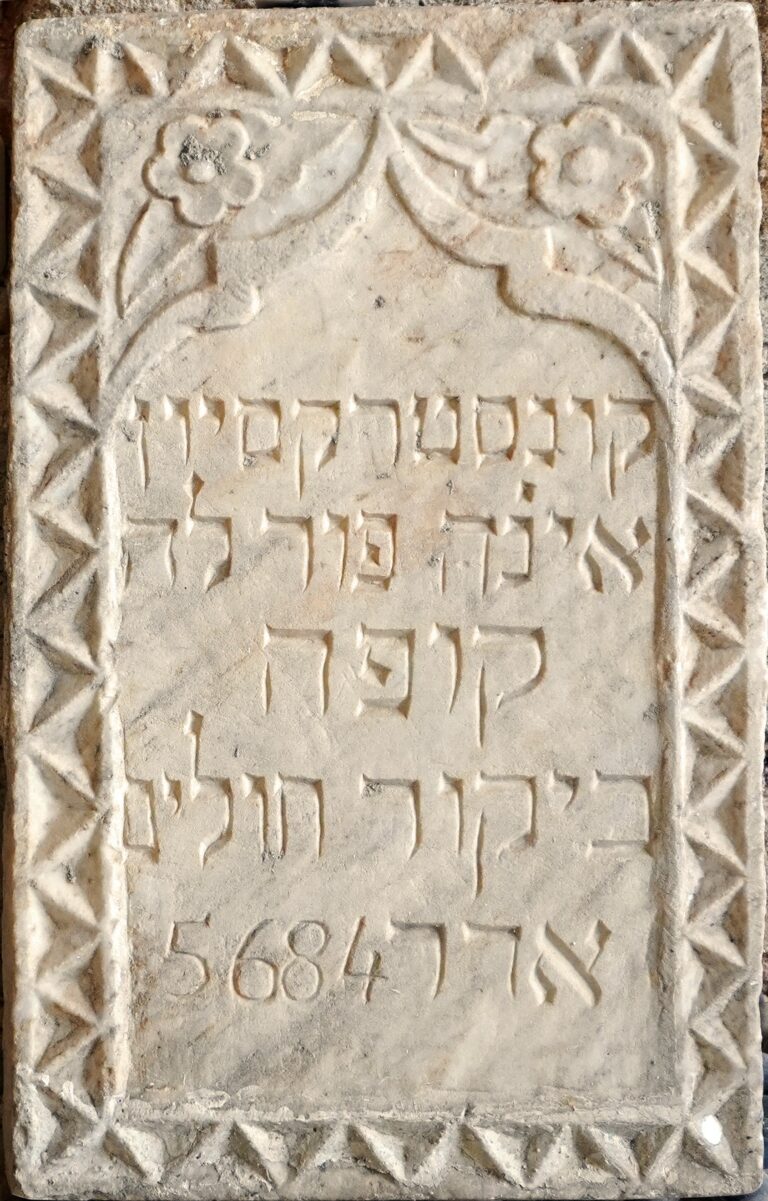
Photo: The 1924 Bikor Holim plaque was formerly located on Kay de la Talmud Torah (also known as Kalijika de la Havra) which is now Vizantiou Street. The plaque has been relocated to the Jewish Museum of Rhodes where it is displayed. The Bikor Holim was one of the three benevolent organizations of the Jewish community of Rhodes. Its purpose was to assist the sick and the deceased (the other two groups were the “Ozer Dalim” and the “Fundo Secreto”). (A Guidebook to the Jewish Quarter of Rhodes by Aron Hasson)
“(During 1936)…our Community was flourishing, and performing many works of progress and charity, which indeed any Community worth its salt must support. Certainly, beyond the traditional charities such as Ozer Dalim and Bicour Holim, it supported various institutions such as our boys’ and girls’ schools…the school Parents Association which sponsored the poor and needy scholars…the Refectory which produced nourishing meals; and the Lady’s Society which was unsparing in its efforts on behalf of the poor and sick. (The Jewish Martyrs of Rhodes and Cos by Hizkia Franco, translated by Joseph Franco)
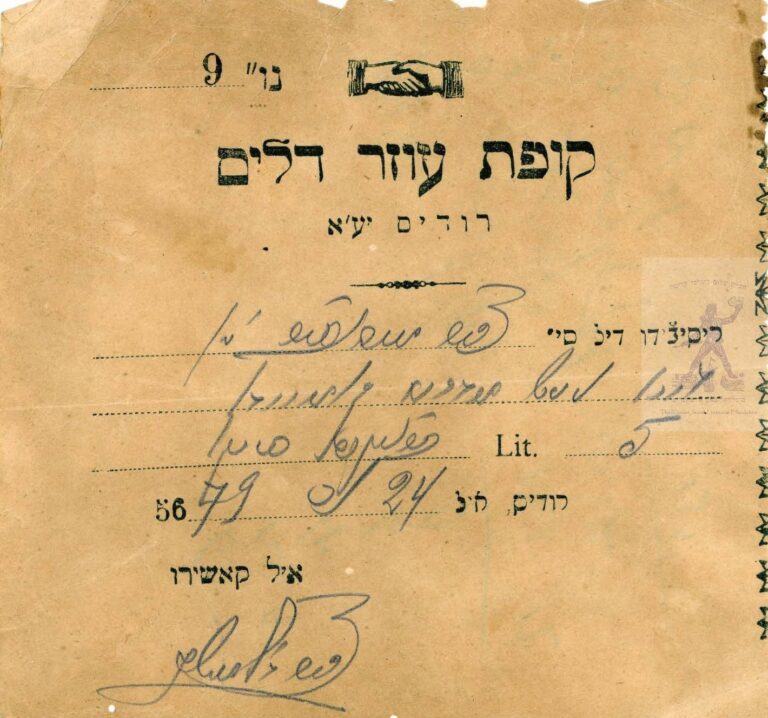
This receipt was signed by the treasurer, Behor D. Almeleh, of the “Kupat Ozer Dalim” beneficial organization. It was given to Behor Mussafir, for his donation of 5 Francs issued at the “Midrash Camondo” in Rhodes on 24 Av 5679 (August 1919).
“Charitable organizations form the practical side of Jewish religious life. Judaism is inconceivable without charitable organizations, which appear and disappear, depending on the amount of activity of their founders and managers or according to unforeseen circumstances; they change names, merge, or function without a name.” (English Translation; From Histoire des Juifs de Rhodes, Chio, Cos etc. by Abraham Galante)
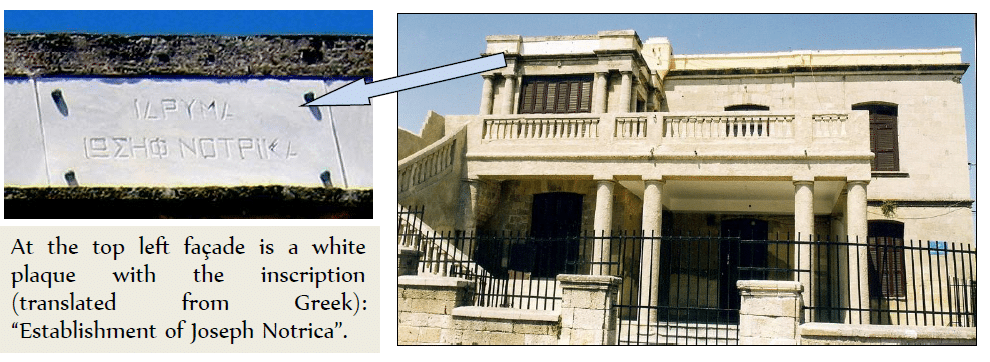
The Joseph Notrica Community Building
“The Notrica Foundation Community Building is located at the north end of Kay de la Eskola (now Kisthiniou Street). It was established during the 1920s to be used as a Jewish Community center for several purposes. The building was donated by the Joseph Notrica Foundation to the Jewish Community of Rhodes. It is now a Greek school. He also donated two other residential complexes (along Ikarou Street) for the benefit of the needy children and the poor members of the Jewish community.” (A Guidebook to the Jewish Quarter of Rhodes by Aron Hasson)
“The Community still had a fine building, called the Foundation Notrica, a Foundation which was established thanks to the generosity of the late Joseph Mazliah Notrica, our great benefactor. The ground floor was used for overflow classes from our school, which was next door. The upper storey housed the Community’s office and those of the Bene Brith association, and a vast hall was used for lectures, and also as a meeting place for all Community activities.”(The Jewish Martyrs of Rhodes and Cos by Hizkia Franco, translated by Joseph Franco)
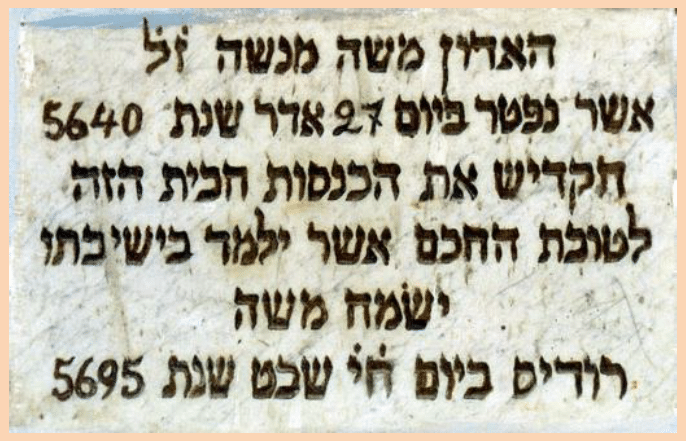
Moshe Menashe 1935 Donation Plaque on the balcony of the Kahal Shalom
Moshe Menashe was known by the name “Kodja Mussani”. He was a well-respected treasurer of the Customs Department of Rhodes and was involved in renovating the Kahal Shalom synagogue and social services of the Jewish community. The plaque pictured here was from 1935, indicating that the house’s income is to assist the Hamam of the Yeshiva. It is one of the three dedication plaques honoring his philanthropic work. (A Guidebook to the Jewish Quarter of Rhodes by Aron Hasson and Ke Haber? June 2023: The Menashe Family of Rhodes based on the article of Abraham Galante, translated by Isaac Menashe)
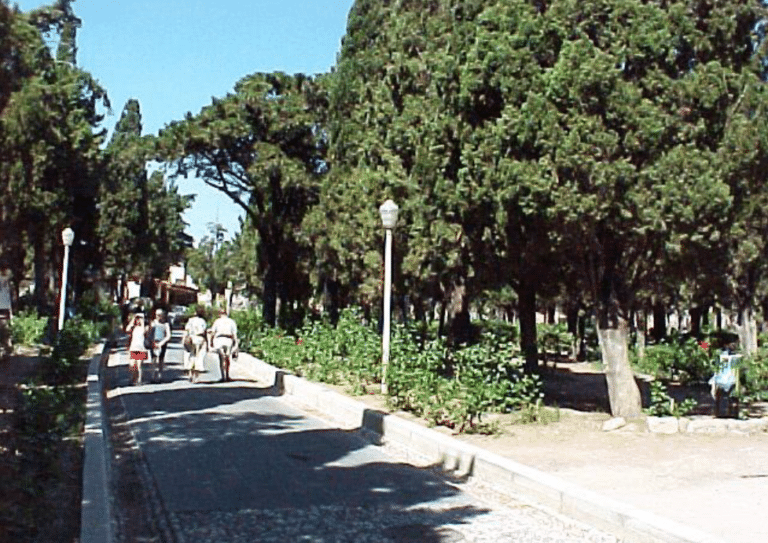
Salomon Alhadeff Park
“This park cross-sects a main part of the old Jewish Quarter. The street running through the park is called Salomon Alhadeff Street. In 1933, the land was donated to the city of Rhodes by the prominent Jewish family of Salomon Alhadeff. In appreciation of this donation, the Mayor of the City of Rhodes, presided over by Alfred Biliotti, named the avenue Alhadeff Street.” (A Guidebook to the Jewish Quarter of Rhodes by Aron Hasson)
“This garden formed the lungs of the quarter, allowing all its inhabitants to breathe more freely, because it was full of flowers and fruit trees. It had belonged to a respected member of the Jewish Community, the late Salomon Alhadeff, founder of the big commercial house registered under the name of Salomon Alhadeff Fils. The late Mr. Alhadeff was the father of Joseph and Acher Alhadeff, the present heads of this firm.”(The Jewish Martyrs of Rhodes and Cos by Hizkia Franco, translated by Joseph Franco)
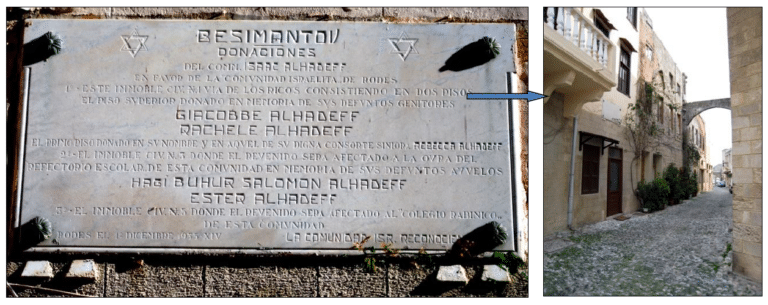
Alhadeff Family 1935 Donation Plaque
Isaac Alhadeff generously donated a portion of his apartments and revenue from his other buildings to enable the Jewish community to assist economically disadvantaged students in continuing their studies. The plaque is located on Kay de los Ricos (now #5 Gavala Street). (A Guidebook to the Jewish Quarter of Rhodes by Aron Hasson)
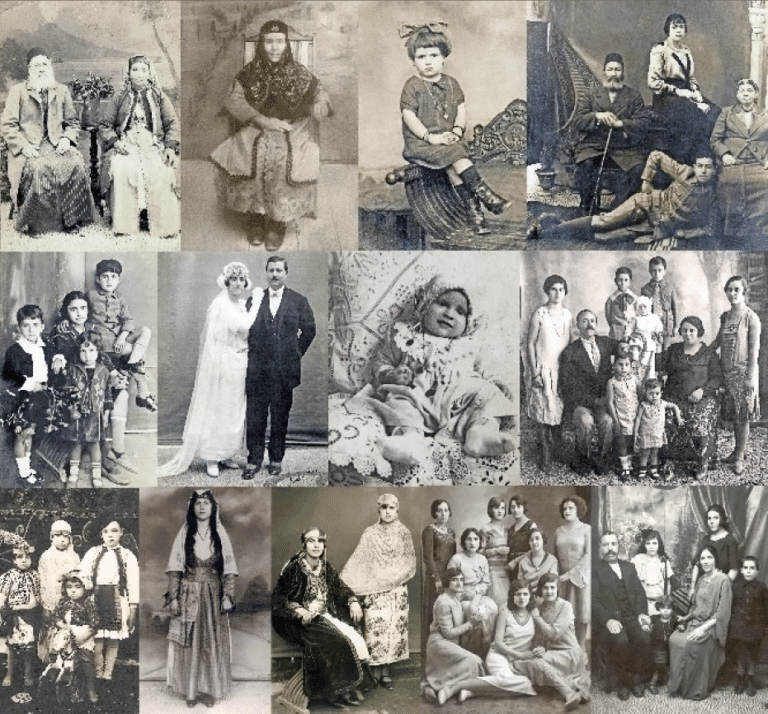
During the Ottoman period, traditional items of clothing were worn, such as fez (headcover), salvar (trousers), and entari (robe) for men; tokado (headdress), entari (dress), sayo (robe), and jube (overcoat lined with fur) for women. A belt was used to secure the entari and was made of cloth or metal buckles. At the time of the Italian occupation, European influences and modernized attire became dominant. (From the book cover of the Jewish Life in Rhodes “Family Portraits” by Aron Hasson)
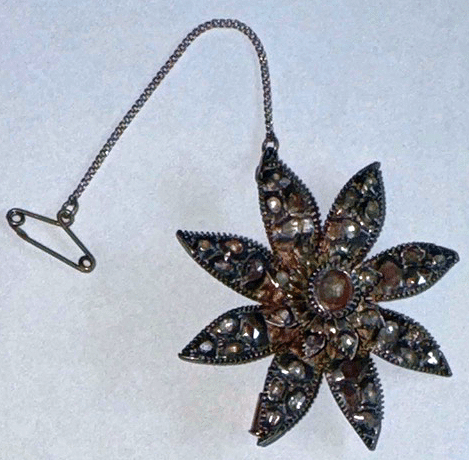
An example of a rozeta. An ornamental pin of the tokado (headdress), a dark-colored cap worn by married women in Rhodes. The rozeta can be made of gold or other metals decorated with diamonds or colored precious stones. It was usually of a flower design, a star or moon shape. During modernization, these were converted into brooches and pendants when passed down to the next generation. From the family of Rochelle Hasson Pinto of Los Angeles.
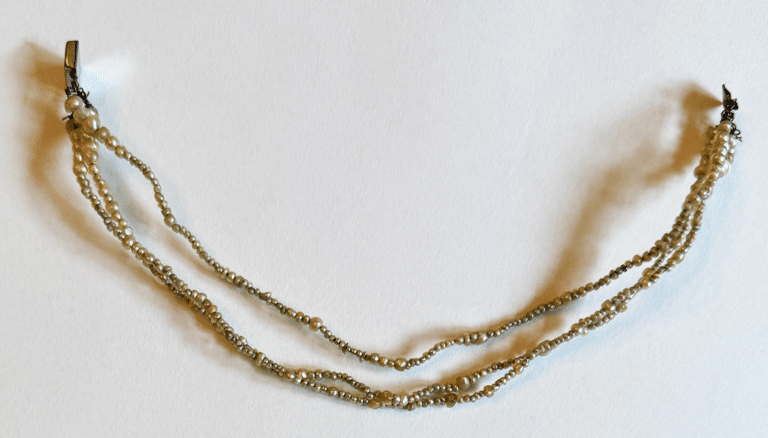
A manajo (also called yadran) is necklace made of pearls. From the family of Rochelle Hasson Pinto.
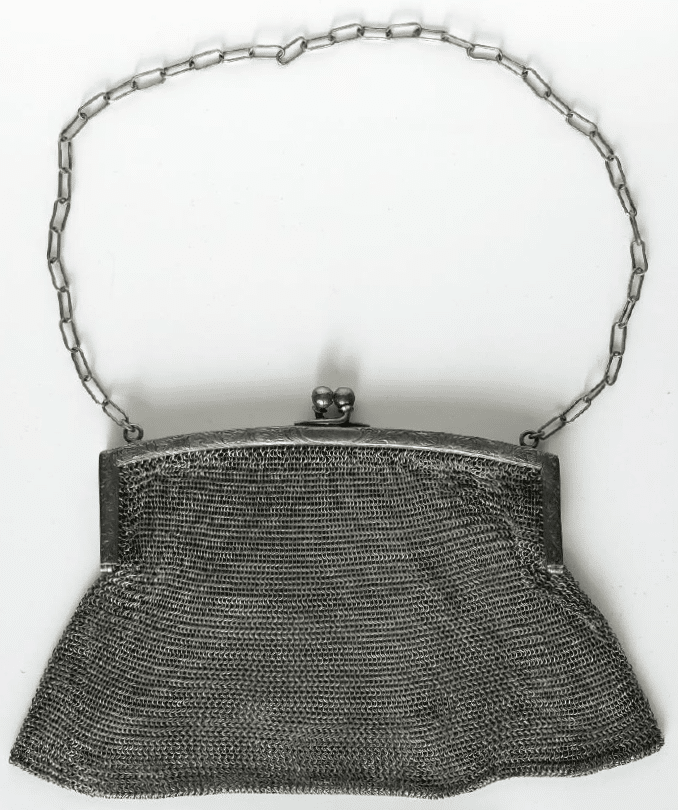
A chantika, is a silver link purse used for special occasions. From Rochelle Menashe Stilwell of Portland.
“The women’s work was never ending. They toiled from sunrise to the late hours of the day…In spite of long hours of housework and raising children, Rhodian women found time to socialize and embroider, to knit, crochet, and sew…Men also had their role to play. They were taught to be responsible for the welfare and maintenance of the family, to be devout Jews and to attend the daily services…What pride they took in ensuring that the children received the necessary religious and secular education, and that the elderly were given proper care. In most circumstances, two or three generations shared a dwelling, with the oldest male holding dominion.” (Jewish Rhodes: A Lost Culture by Isaac Jack Levy)
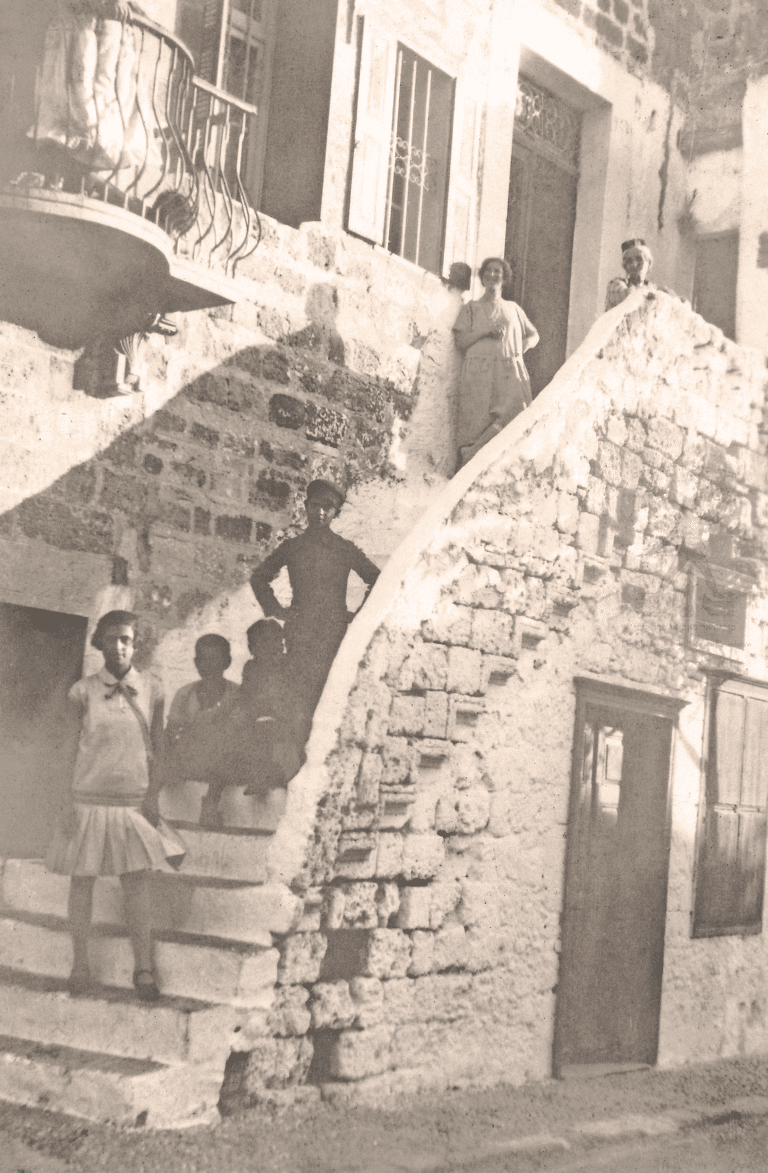
Three generations at the stairs of the Benveniste family home. From Jeanette Benveniste.

The Benveniste family at the courtyard. Notice the washed clothes on the clothesline to dry. From Shirlee and David Peha.
Photos: Sisters Selma and Stella Levi (little girl) at the home of Luisa Hasson. Notice the floor sheshikus and windows draped with kortina (laced curtains). From Stella Levi.
A 1928 photo of Sara Levi (front), Rosa Levy (seated on the bed) and with a woman standing (unknown) in a room full of bordados (embroideries).
“After that, and threaded all through the day, singing as children walked to school and back, as babies were put down for their naps, as young people gathered, and as women cooked or, later, as they embroidered deep into the night.” (One Hundred Saturdays~ Stella Levi & the Search for a Lost World by Michael Frank)
Handmade bordados (embroideries) from Rhodes using different needlework techniques. From the Jewish Life in Rhodes Exhibit, San Diego, 2023.
At the Habib family home. From Isaac Habib.
“As I am writing, my eyes fill with tears remembering these beautiful childhood days, when after finishing our chores, all the neighbors would gather to have afternoon coffee, with freshly baked bread and boyos (spinach cheese pie). All the children would sit in a circle around the mothers in the courtyard. (I Remember Rhodes by Rebecca Amato Levy)
“They spent all day together. Seated round the table covered with fruit, while chatting, laughing and gossiping, they worked, dividing the work. The first peeled the fruit, the second removed the pips/stones, the next one sliced it wile the last took it to the kitchen where another team busied themselves at the stove, after a series of operations about which I have forgotten, transformed the fruits into succulent preserves, marmalades, jellies or candied fruit.” (Le Chene de Rhodes by Vittorio Alhadeff, English translation by Rachel Alhadeff Roditi)
“Mother had filled the table so full that the entire surface was covered. The table seemed an overloaded testimony to the bounty of life on Rhodes. In addition to Uncle Rahamim’s palamida, there was kapama, a baked dish made of chopped tomatoes, onions, green peppers and parsley; tomat, preserved green tomatoes; broiled beef patties, freshly baked coarse bread and rolls; a variety of appetizers and side dishes prepared by my aunts. For the adults, the meal was accompanied by raki (a liquor that had given the men a jolly glow since early afternoon)…there would come another wave of delicacies; roasted watermelon seeds, roasted chickpeas, white raisins, and Grandmama’s sponge cake.” (During Sueda de Purim, The Juderia by Laura Varon)
“Yet the results emanating from Sephardic kitchens were varied, nutritious, delicious, and appreciated by all. Daily meals were adequate and festive occasions were sumptuous. To cater for celebrations, the ladies used to congregate in someone’s kitchen and there would be a hive of activity, then, from the organized chaos would emerge a huge array of foods that looked fabulous, smelled great and tasted scrumptious. Hospitality was a keynote of the way of life there as there was no commercial entertainment, and people frequently visited each other without the need of an invitation. For these occasions Turkish coffee, cookies and homemade sweets were always available and served.” (From the Recipe book: Las Comedicas de Rodis by Solly Menashe)
“Rosa Avzaradel, originally from Rhodes, recalled a mysterious ailment that had afflicted her mother when she was a young girl. “There was no doctor that didn’t see her. There was no solution. They would say that she had nothing. That she was OK. But there were buenas mujeres. They used to do good deeds…they were good women.” (Ritual Medical Lore of Sephardic Women by Isaac Levy and Rosemary Zumwalt)
“Her first words upon entering the home were traimi un punado de sal! (Bring me a fistful of salt!) When it was brought, she asked rhetorically: kual es esto?(what is this?) “Sal”, salt came to answer (*the use of salt in dissolving all the impurities)…”(I Remember Rhodes by Rebecca Amato Levy)
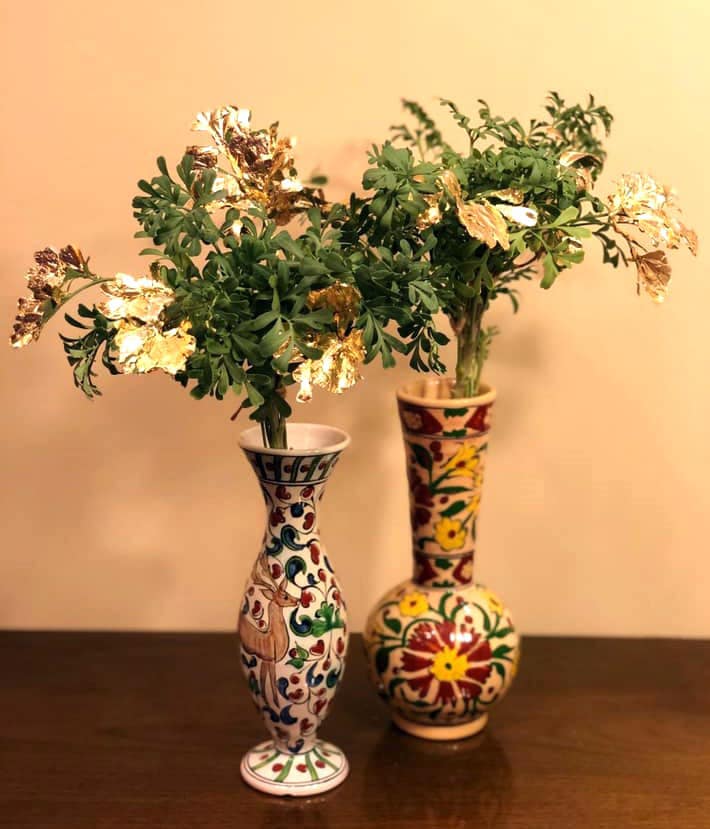
These sprigs of homegrown aruda (rue), considered a “good omen” plant, were decorated with alvarak (gold leaf) and placed in ICARO vases from Rhodes. They were presented during a baby naming ceremony in Los Angeles.
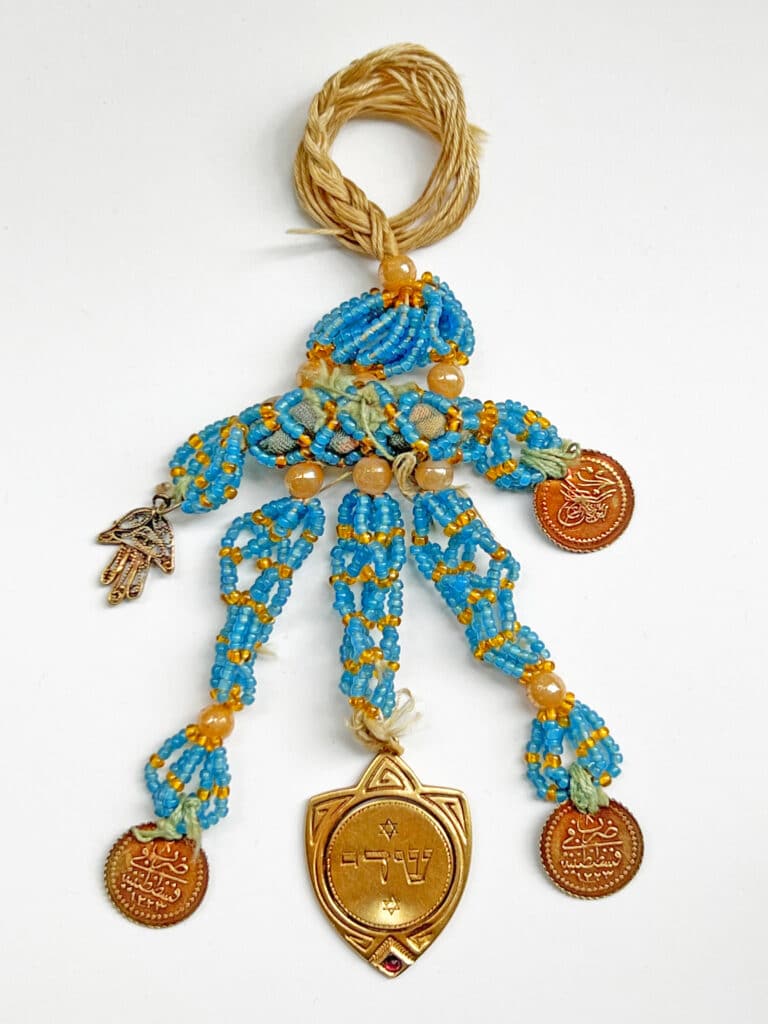
Mazal Bueno from Rhodes of Regina Algranti Soriano passed down to her great-granddaughter Rachelle Pearle Hasson.
From article, Our Mazal Bueno: A Rhodesli family keepsake then and now
We welcome everyone’s Mazal Bueno or any historical artifacts to be featured on this website and future publications; email us: info@rhodesjewishmuseum.org
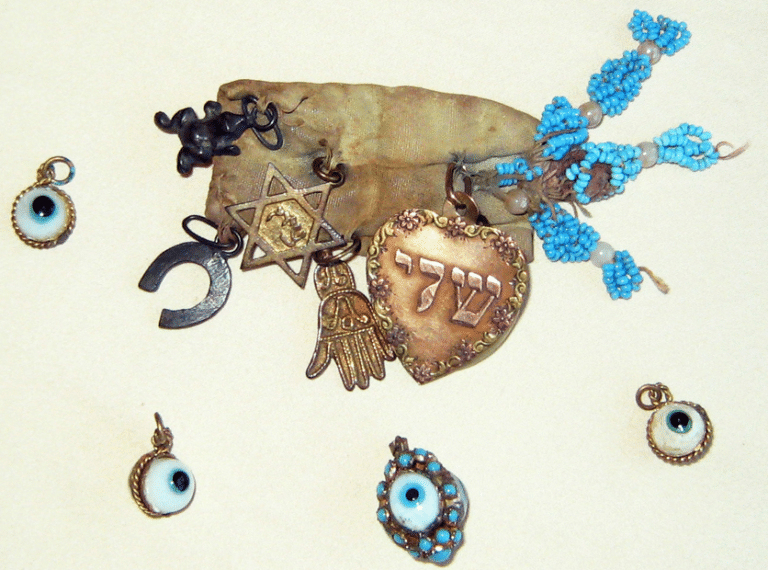
The mazal bueno (good luck charms) and “oju” (eye) from Rhodes were typically hung around the baby and crib. They were combined with other protective objects pinned or sewn onto a “bulsika” (little sack) that sometimes contained garlic or salt as protection against the evil eye (malu oju). From the family of Sepora Amato Benoun of Los Angeles.
Shaddai pendant from Frances Franco.
“The infant was also given small gold ornaments, such as Shaddai plaques, mezzuzot, and hands…” (Sephardi Jews in The Ottoman Empire by Esther Juhasz)
Notice the dukado (gold coin) and the blue beads sewn together that can pinned on the baby’s clothing or crib. From Rochelle Hasson Pinto.
Modern-Day Ojus and Mazal Bueno
“From his childhood in Rhodes, Isaac remembers that the children were taught by their mothers to guard their tongues from speaking evil. To convey this, his elders used formulaic phrases: “Avla bien para ki ti venga bien (Speak well so that good will come to you)”; and “Avla bueno para ke te salga bueno (Speak well so that good things will happen to you)”. These were paired with other phrases that cautioned against thinking evil, “El ke mal pensa, para si se lo pensa (He who thinks evil, thinks evil thoughts of himself)”, and “Ke mal tenga ken mal pensa (May evil strike the one who thinks evil).” Isaac’s mother and his grandmother repeatedly cautioned his brother and him against speaking maliciously, and even against thinking bad thoughts because these would bring harm.” (Ritual Medical Lore of Sephardic Women by Isaac Levy and Rosemary Zumwalt)
Some examples of proverbs from the article, The Proverbs and Popular Sayings of the Spanish Jews by Isaac Jack Levy and Dale E. Enwall from the book: Sephardim, a history of Congregation Or VeShalom, published in 1981.
Some examples of superstitions (translated into English) from the book of Abraham Galante: Histoire des Juifs de Rhodes, Chio, Cos etc., published in 1935.
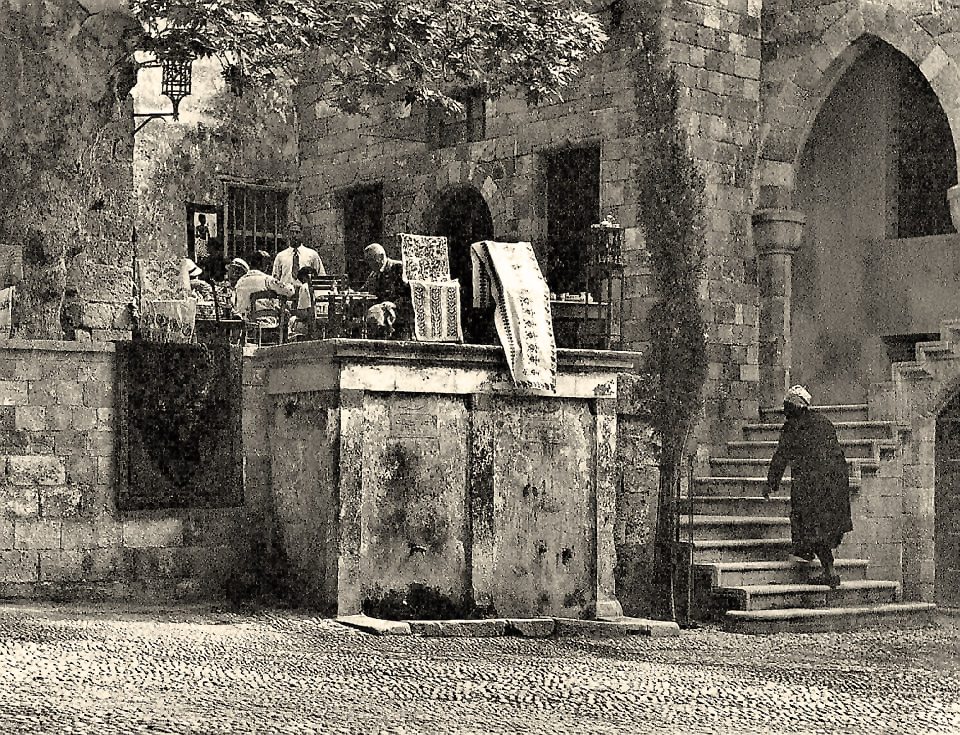
1934 Cafe at the Museum Square, a place to chat (echar lashon)
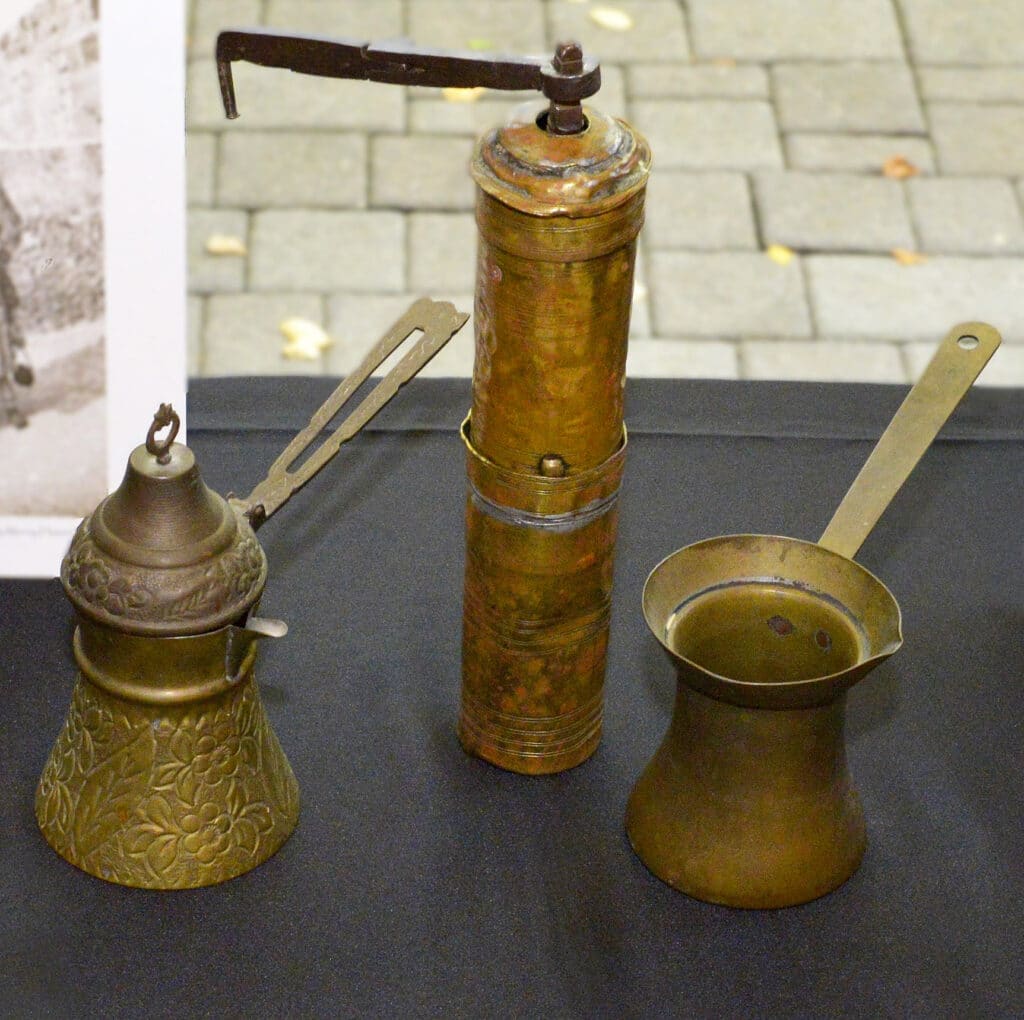
Samples of cezve which were used in making kave turko (turkish coffee). The coffee grinder seen here is from Selma Franco Jaffe of Los Angeles. (From the Jewish Life in Rhodes, New York, 2023).
1930 group of women in Rhodes enjoying kave turko in finjanes (demitasse cups) at the cortiju (courtyard).
1935 at the Mandraki fountain
“It was in the Mandraki that the young, aspiring to marry, found the most romantic setting…It was a spectacle, both amusing and touching, to see these young men and women walking from one end of the square to the other, backwards and forwards, crossing and crisscrossing each other exchanging silent looks day after day until the moment when the divine spark sprang, and the couples formed.” (Le Chene de Rhodes by Vittorio Alhadeff, English translation by Rachel Alhadeff Roditi)
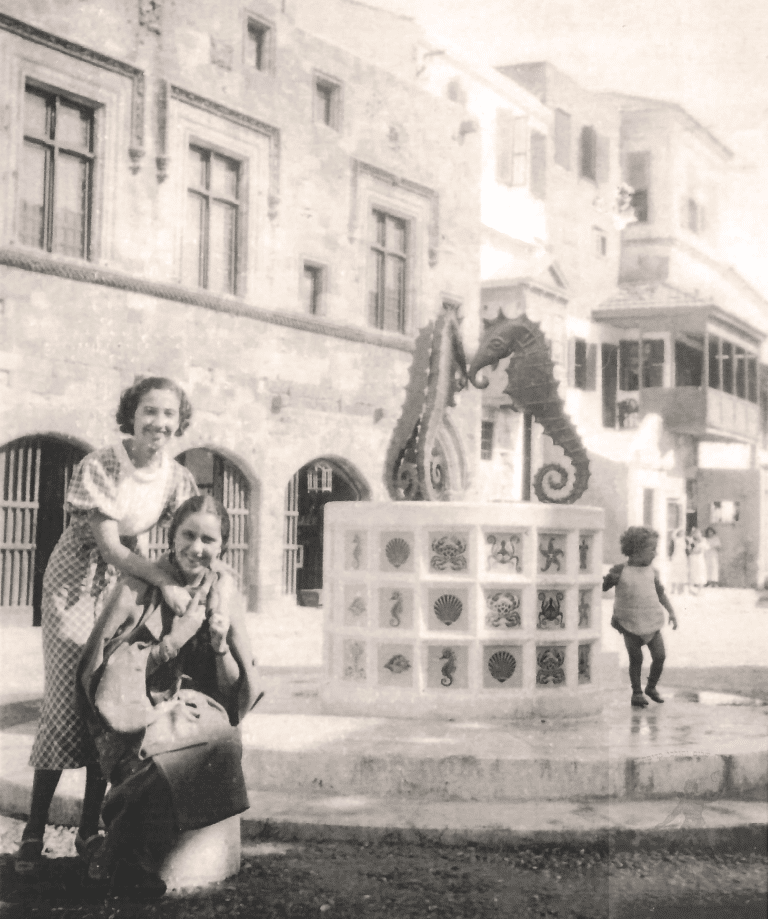
Susan Misrachi and Diana Capelluto next to the seahorse fountain along La Kay Ancha. From Esther Israel Pearlman.
“In Rhodes the Kay Ancha and the Mandraki were the two main places where people would congregate, meet others and socialize. The Kay Ancha was in the center of the Juderia; it had a large fountain where the young women would draw water for their families. The Mandraki was near the water on the outskirts of the Juderia (*where socialization and intermingling took place during the Italian occupation)…According to Rebecca Levy, during the 1930s, a ballroom called La Ronda was built at the end of the Mandraki. Rebecca explains that this ballroom was primarily attended by the Jewish population and that Jewish teenagers would go to dance all the modern dances of Europe (foxtrot, two-step, waltz, etc.) to a Victrola…(another) was a private Italian Country Club called the “Circolo D’Italia”, used by Italians and the Jewish elite until 1939 when Jews were no longer allowed to join the club.” (Dance Among the Sephardic Jews from Rhodes by Marcia Aron Barryte)
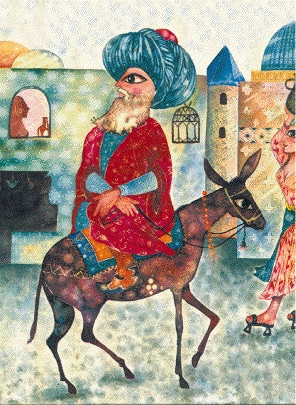
Nasreddin-Hoja and his donkey (1750)
“Storytelling was a favorite pastime in Jewish Rhodes, for children and adults as well. The most popular folk-hero was Joha, or NasrEddin-Hoja, a character created by the Arab imagination and greatly developed in Turkey. It soon became famous in the entire Ottoman Empire, including its juderias. (A History of Jewish Rhodes by Esther Fintz Menasce)
“Father’s many tales were a special source of happiness for all of us. As long as we could remember, Saturday evening after Havdallah had been filled with tales of Djoha, Ginha, or any of several other folk characters from our Turkish and Spanish traditions. And while many of father’s stories would simply invoke laughter, Saturday evening tales always seemed to be chosen for their moral, for the life’s lesson they might impart. These were the stories I loved most.” (The Juderia by Laura Varon)
“A particularly substantial building belonging to the Knights anchored the Kay Ancha, one of the main piazze of the Juderia; after the Italians came, they installed a cultural institute within its noble stone walls, the Dante Alighieri Society, which extended the notion of beyond in several ways. The Dante Alighieri housed an extensive library, and naturally nothing took a young, curious, and alert boy or girl so far beyond as books.” (One Hundred Saturdays~ Stella Levi & the Search for a Lost World by Michael Frank)
Photos: A booklet, Lady of the Camellias by Alexander Dumas in Rashi script, printed in 1922 and Leon Levi’s postcard describing the Dante Alighieri library as a place where they go to read books and attend concerts.

The Il Messaggero di Rodi (1912-1943) was the official local daily paper in Rhodes.
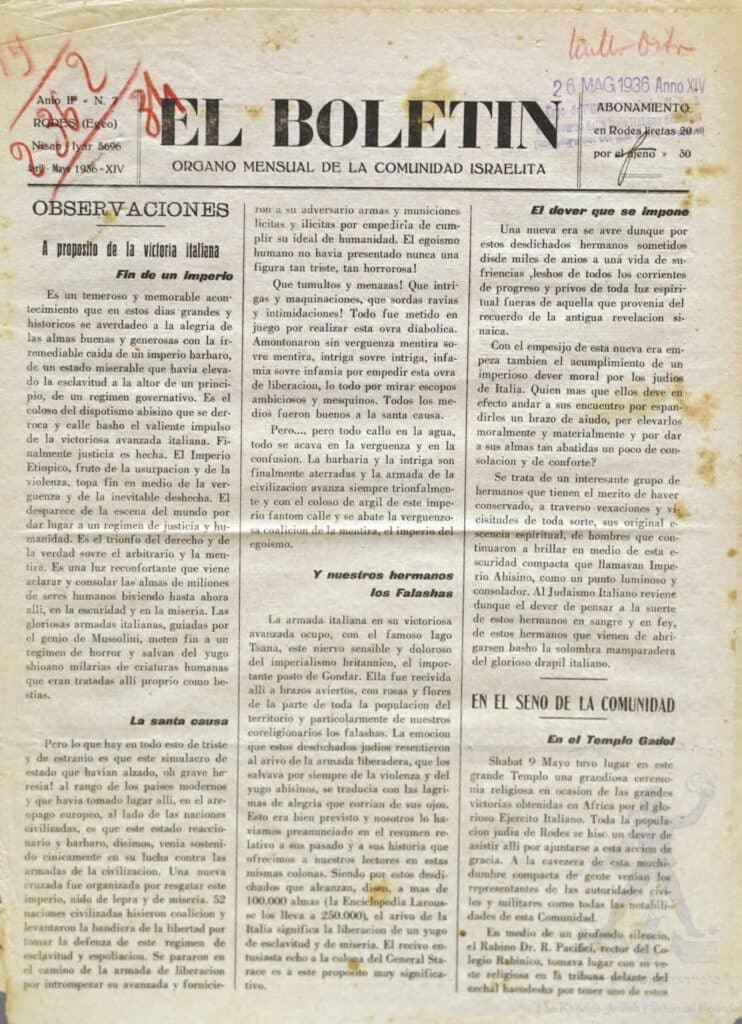
The El Boletin (1934-1936) was a Jewish Publication of Rhodes written in the Judeo-Spanish language and was edited by Hizkia Franco.
According to Abraham Galante, Bulelino Mensual, published in 1928, became the official newsletter of the community; however, the Bulelino didn’t last and was defunct. Another newspaper, Selam, was published from 1926 to 1936 and catered to the Turkish and Jewish readers of Rhodes. The paper’s director was Mehmet Kadri, while the editor-in-chief was Hizkia Franco.
The Jews of Rhodes are well known for their “romanzas” and “canticas”. These were romantic folk songs in the Judeo-Spanish (“Ladino”) language. They are part of the rich culture and heritage brought by the refugees of the Spanish Inquisition. They were most frequently sung without instruments, in the home, while cooking, as lullabies to put children to sleep or accompanied by musical instruments (typically the ud, mandolin and other string instruments) at family and communal gatherings.
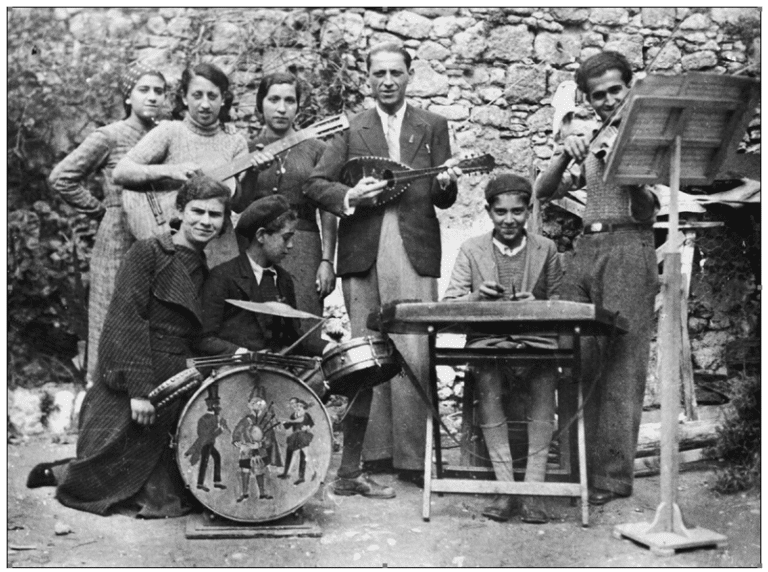
1930s photo, left to right: Esther Galante, Estrella Galante (with guitar), Victoria Alkana Notrica, Joseph Notrica (with mandolin), Nissim Pilosof (with sandour, “kannon”), Isaac Pilosof (with violin). In the front left are Sara Leon and Peppo Pilosof (with drum). From Miru Alcana.
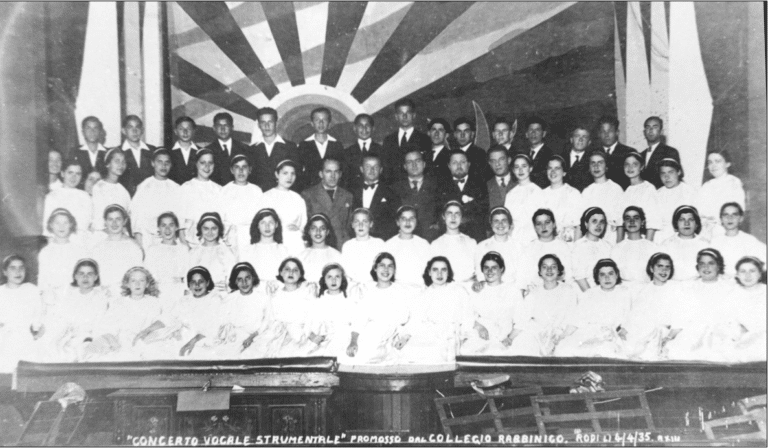
1935 photo of “concerto vocale strumentale”, a collaboration of the Rabbinical College with the Jewish Italian school.
“Alberto Hemsi published the first two of the ten fascicules, each including six songs, which make up his Coplas Sefardies. By coplas, Hemsi means both romansas and cantigas: thus, his collection is both a romancero and a cancianero. He collected the first twelve songs in Rhodes…From 1924 to 1927, he lived in Rhodes where he taught music (one of his students, Myriam Capelluto, was to become his wife in 1930) and continued collecting words and tunes of Judeo-Spanish songs.” (A History of Jewish Rhodes by Esther Fintz Menasce)
The calendar cover features Selma Levi Mizrahi wearing a ceremonial dress, sirma kaftan while playing the ud in Flushing, New York. The border design was from the floral embroidery of her dress belt. The historical item was from the family of Esther Mizrahi Weissman and is displayed in the Jewish Museum of Rhodes.
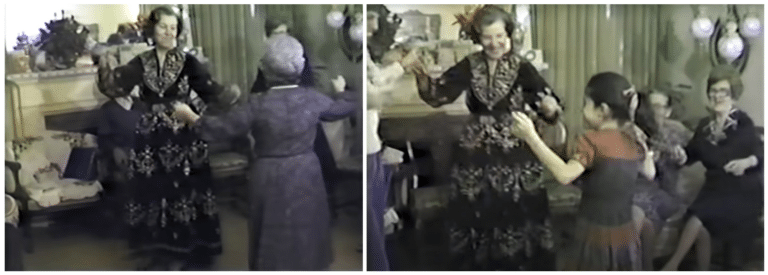
Screenshots of Selma Levi Mizrahi, wearing her sirma kaftan while dancing “a la Turka” in Los Angeles. From the video: Sephardic Women from Rhodes demonstrate their culture by Arthur Benveniste.
“Dancing a la Turka (in Turkish style) is usually done in couples with men and women facing one another. A la Turka dancing has also been observed danced by men and women in a closed circle in a counterclockwise direction, but without physical contact…Small arm, hand and upper torso movement dominates women’s movement, whereas the men tend towards more hip, foot movements and larger arm movements. First generation men commonly will accompany themselves with slaps, stamps, and claps whereas first generation women will accompany themselves only with snapping and/or singing. Successive generation men and women’s movement tend to be similar movements of the first-generation men.” (Dance Among the Sephardic Jews of Rhodes Living in Los Angeles by Marcia Aron Barryte)
Football (soccer) was by far the most popular sport among the Jews of Rhodes during the 1930’s. In fact, the Jewish men were known as the best players on the Island and were therefore the favorites in all competitions. There were 3 football (soccer) teams. First there was the Maccabi. The second one was known as the G.E.R., which is an abbreviation for Gioventú Ebraica Rhodes (Young Jews of Rhodes). The third team was called the Citta Murata Jewish football team.
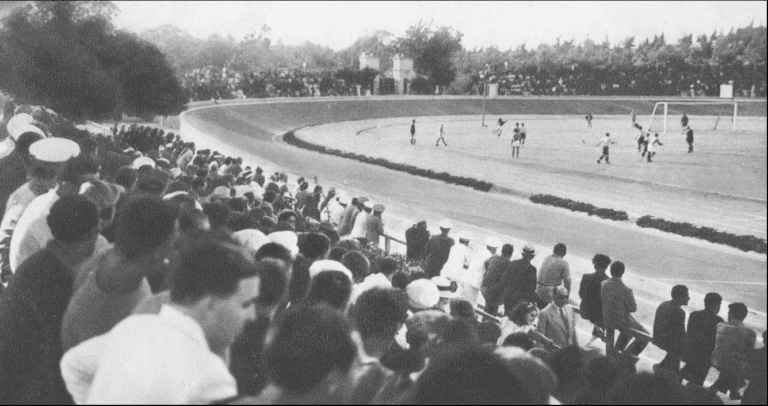
A crowded stadium of an important football soccer game. This stadium was situated just outside the Old City of Rhodes, near the Jewish Quarter.
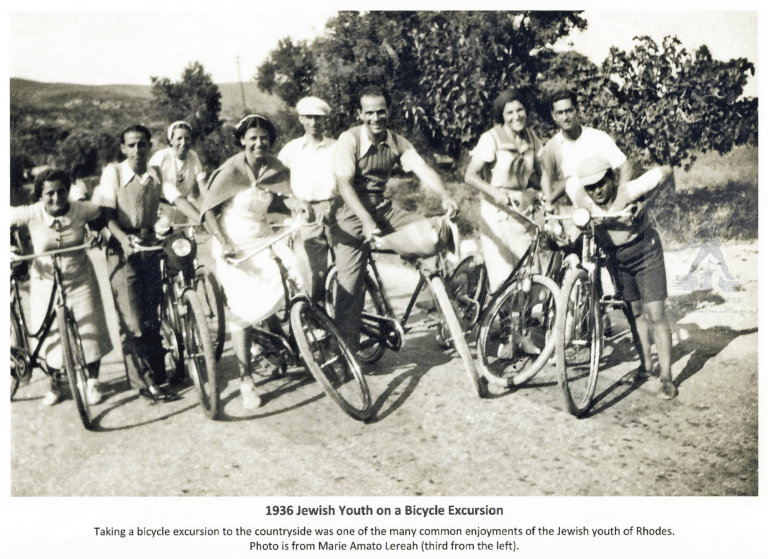
“The road near the village of Trianda is lined with fig trees and among them stands an Amora…the Amora turns the still air syrupy with the vanilla-like scent of its flowers. And this spring morning, Uncle Rahamin, Jaco, Salvo and I sat quietly at its base, recovering from the efforts of the bicycle ride up from Rhodes…Perhaps I savored the moment most of the group, for as its youngest member, my opportunities for these adventures away from home had been few. (The Juderia by Laura Varon)
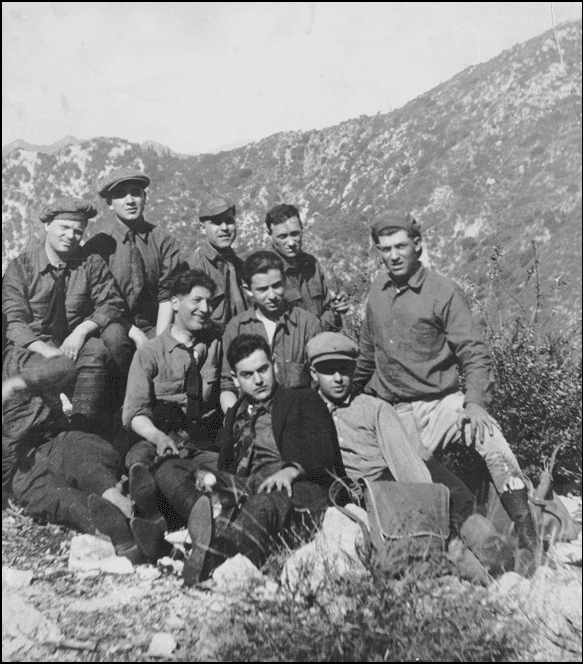
1930’s photo of a group of young Jewish men mountain climbing in the central region of the Island of Rhodes. Atáviros, the highest peak, is 4,000 feet above sea level. At the left: Jack Cohen, third from left in back is Jack Notrica.
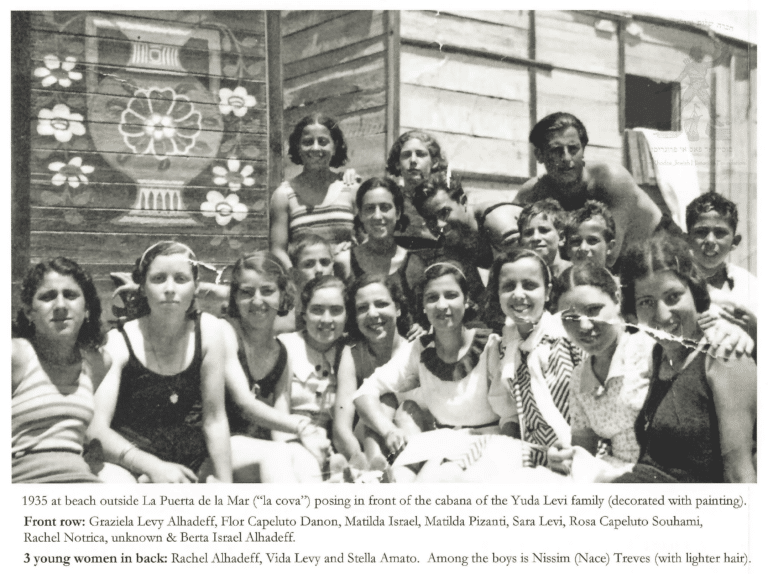
1935 at the beach outside La Puerta de la Mar. Notice the beautifully painted cabina.
1937 at the beach near La Puerta de la Mar
Having the beautiful Aegean Sea located right outside the Jewish Quarter made it a popular place to socialize and have fun. Residents of “La Juderia” would only need to take a short walk through what they called “La Puerta de la Mar” (one of the few doorways of the walled Old City of Rhodes) in order to reach the sea. Several Jewish families had cabins (“cabinas”) along the beach which they used as bungalows.
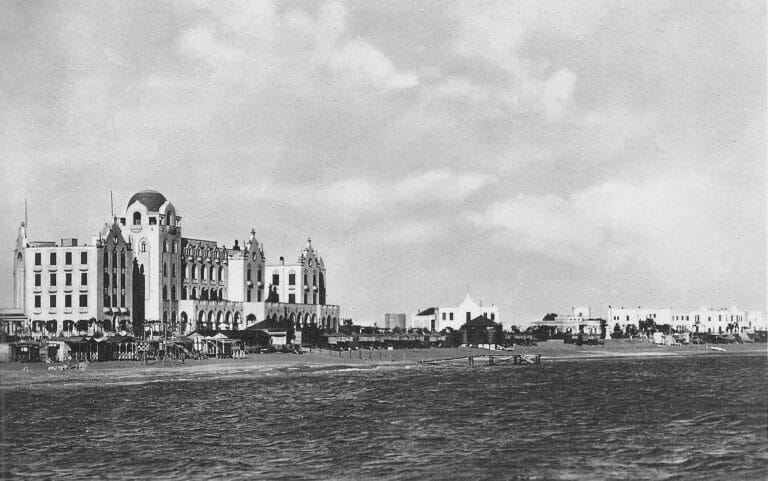
1926 Hotel L’Albergo delle Rose
During the 1920’s and 1930’s, the Italian government began special projects to develop the New City of Rhodes. Included in these plans was the building of the Hotel L’Albergo delle Rose, situated at a prime location along the beach in the New City. This became a popular place and included Jewish residents who took walks to the New City beaches via “La Mandraki” (the new marketplace). Currently, large luxury beach hotels are located in that area.
“The only things that interested me were swimming in our beautiful sea, playing like crazy in the streets and staying out until dinner joking around. All the boys had swimming in their blood; there were many of us who, after school and a nice swim, used to jump and play around in the streets until we would return home, dusty from head to toe, with salt still in our hair.” (For This I Lived by Sami Modiano)
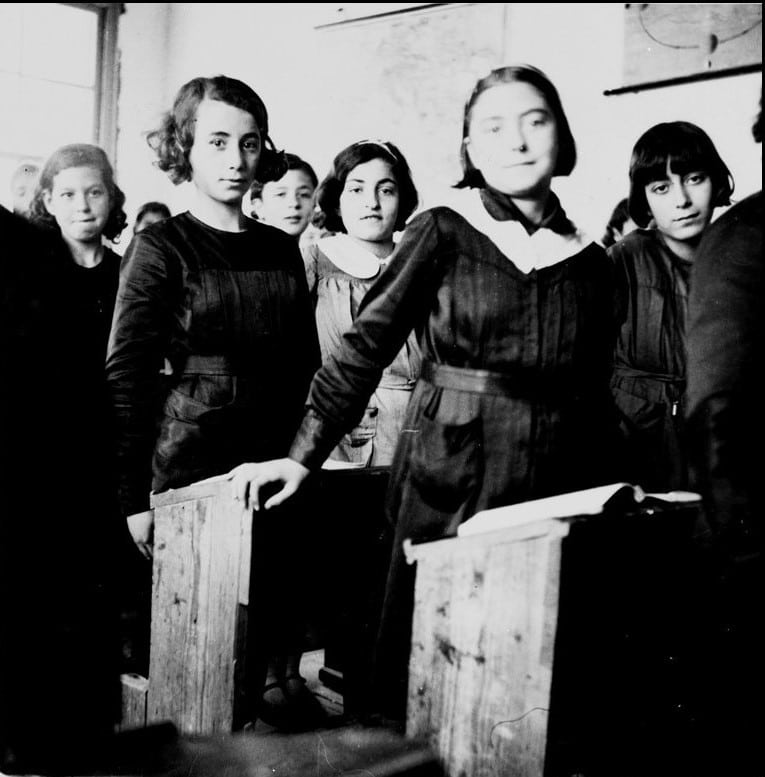
1932 students of the Scuole Israelitiche Italiane standing behind their desk, L-R: Allegra Franco, Lucia Touriel, Rene Capelouto, Allegra Alhadeff, Rosa Israel and Lucia Soriano.
“During an August 1903 visit to Rhodes, the Baron and Baroness de Rothschild donated 15,000 francs to build the school. The building (“Alliance Israelite Universelle”) completed at the end of 1904. During the Italian occupation, the school changed its name to “Scuole Israelitche Italiane”. (A Guidebook to the Jewish Quarter of Rhodes by Aron Hasson)
“In June 1917, the government decreed that all schools in Rhodes–Turkish, Greek and Jewish would henceforth be under the control of an Italian inspector-general…The Italian officials made frequent visits to the schools, testing the students on questions of Italian geography, proverbs and general Italian culture…Indeed, progress in Italian in the Jewish schools advanced at the rapid pace.” (The Jews of Rhodes by Rabbi Marc D. Angel)
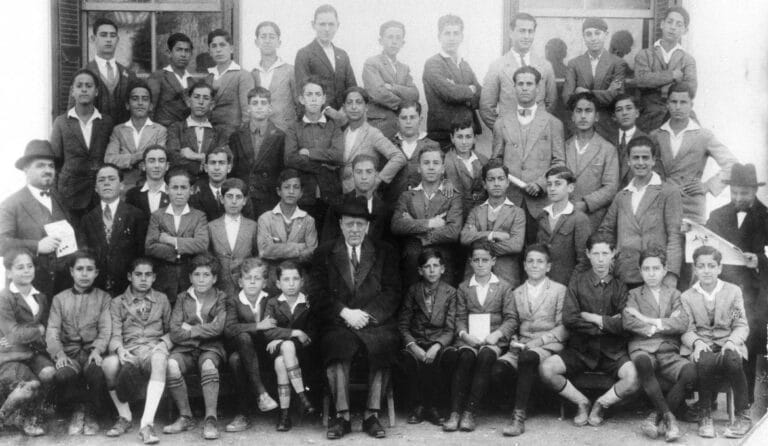
1930 of the boys’ class of the upper three grades of the Jewish school. This photo is from one of the students, Herzl Franco, located on the top row, third from the left. The school principal, Mr. Da Fano is sitting in the center. The Hebrew Professor, Mr. Michaeloff, is on the left and the Italian Professor, Mr. Ayo, is on the right (reading the newspaper).

1934 of the students at the Jewish school. Front row, L-R: Matti Berro, Sarah Hasson, Lucie Habib, Clara Barki, Rosa Cordoval and Rica Capouya. Second row: Rosa Capelouto, Clara Gabriel, Sarah Benatar, Professor Michaeloff, Perla Levy and Allegra Taranto. Third row: Allegra Israel, Allegra Alhadeff, Professor Cohen, Professor Carabia, Guedalia Franco, Ruben Alhadeff, Moshe Hasson and Jacques Hougnou. Top row: Yair Raphael Franco, Moise Alhadeff and Mr. Vidal.
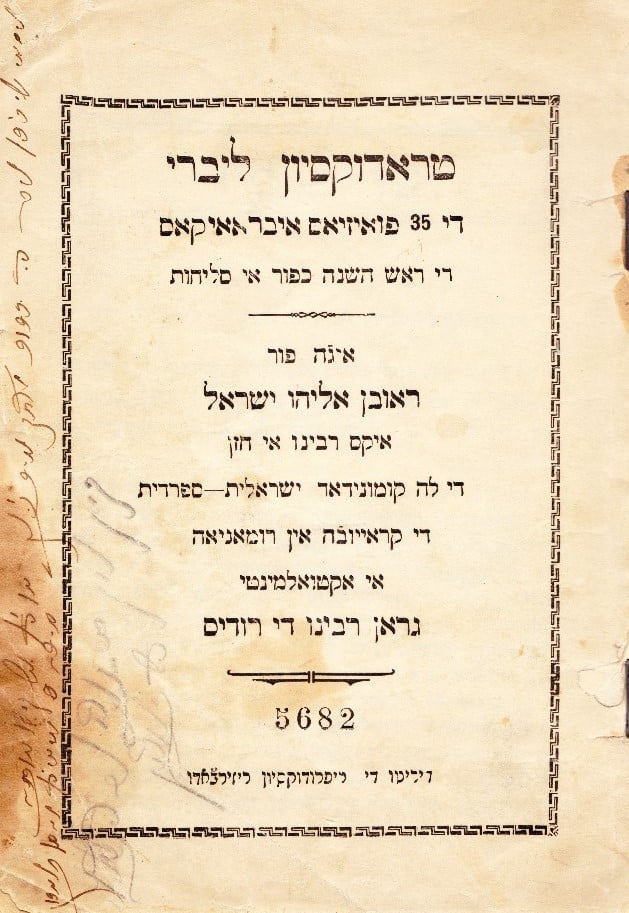
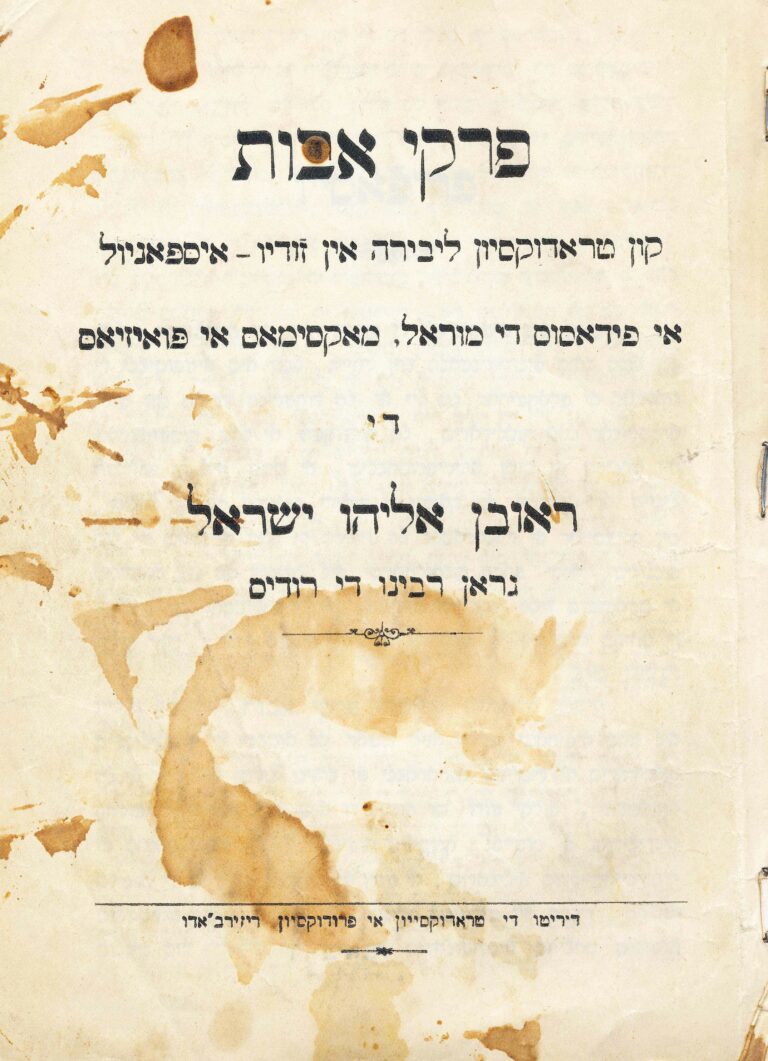
Photos: Booklets translated into Judeo-Spanish by Grand Rabbi Reuben Eliyahu Israel
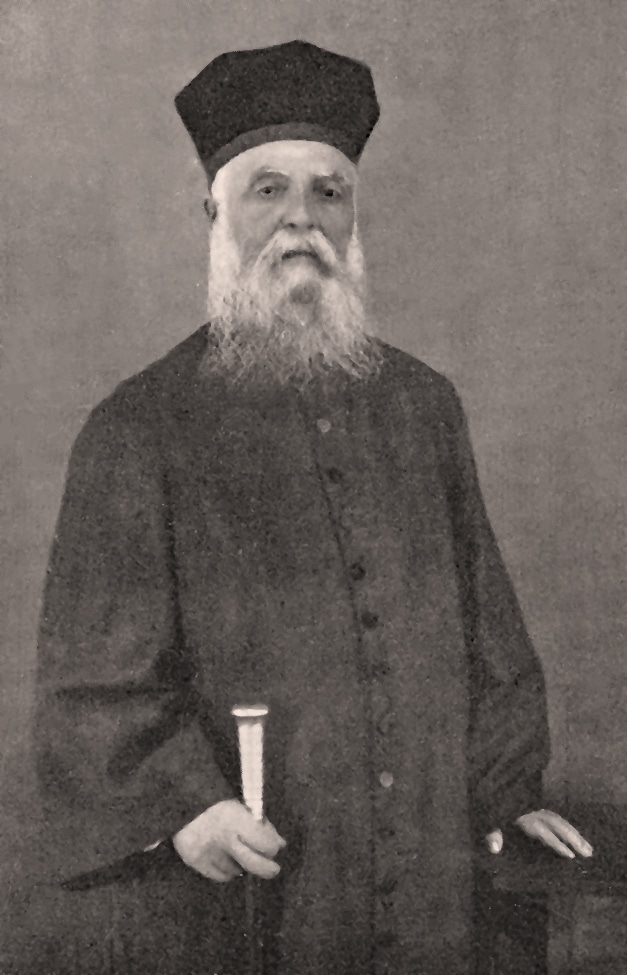
Grand Rabbi Reuben Eliyahu Israel
“Chief Rabbi Reuben Eliyahu Israel’s life reflected the tensions between tradition and modernism… (Rabbi) Israel called for educational reforms. He translated the Psalms and Proverbs into Judeo-Spanish, especially for the use of students in the Jewish schools… Rabbi Israel was particularly concerned that children should study the history of their people…In one of his sermons given in Rhodes while he was a Chief Rabbi, he insisted: “tenemos un dover sacro de studiar profundamente nuestra istoria para saver quien somos nosotros.” (We have a sacred obligation to study profoundly our history in order to know who we are.) (The Jews of Rhodes by Rabbi Marc D. Angel)
Rhodes Jewish Historical Foundation